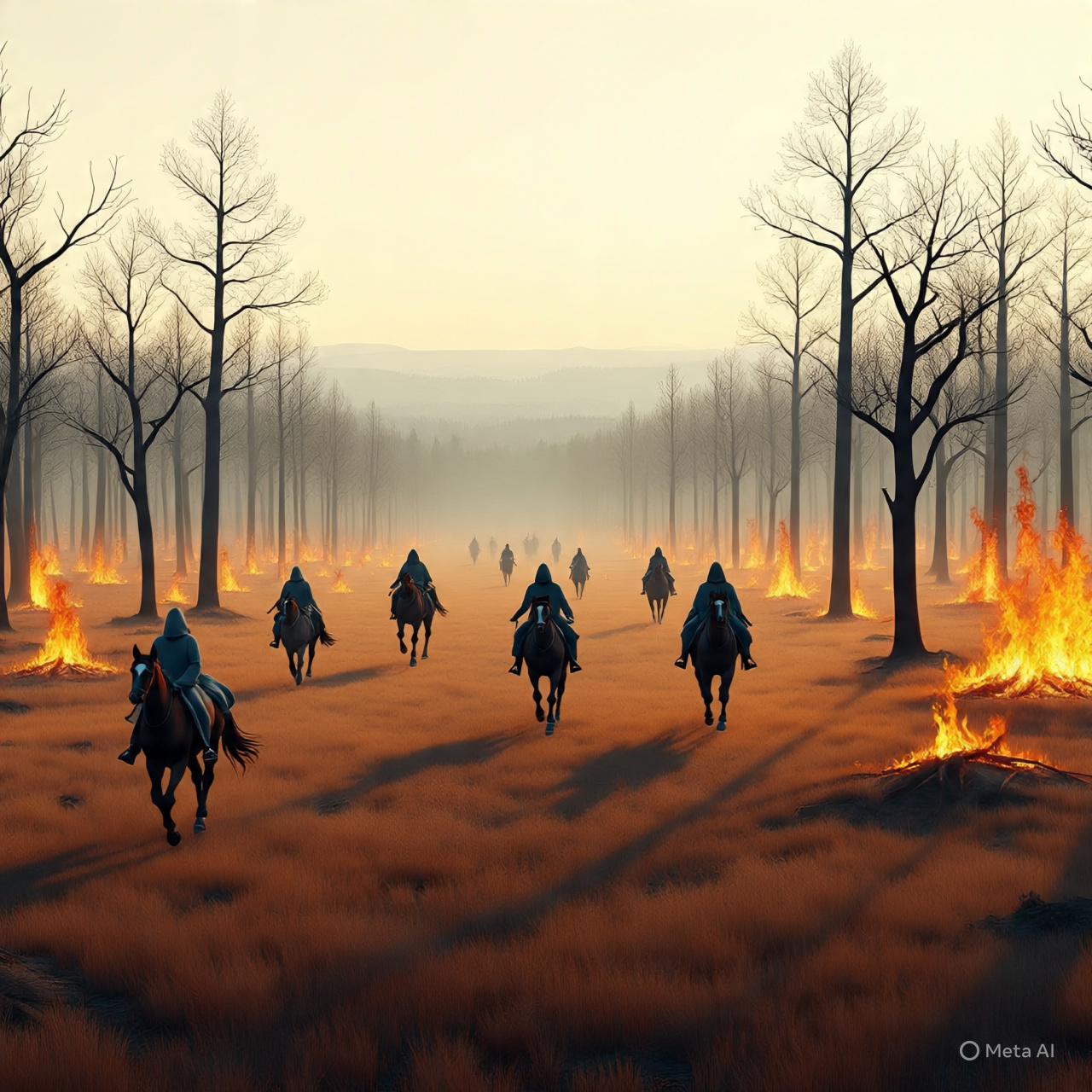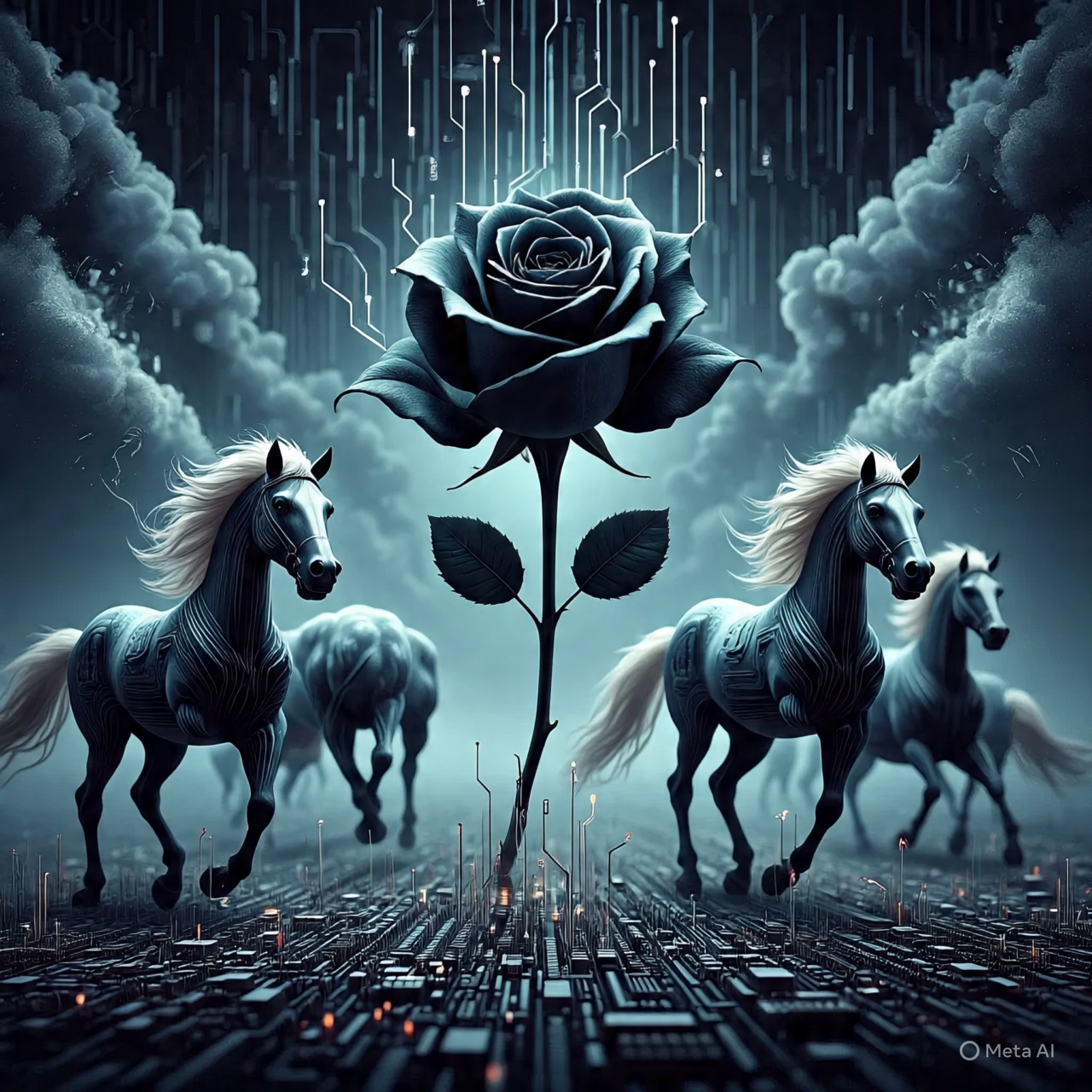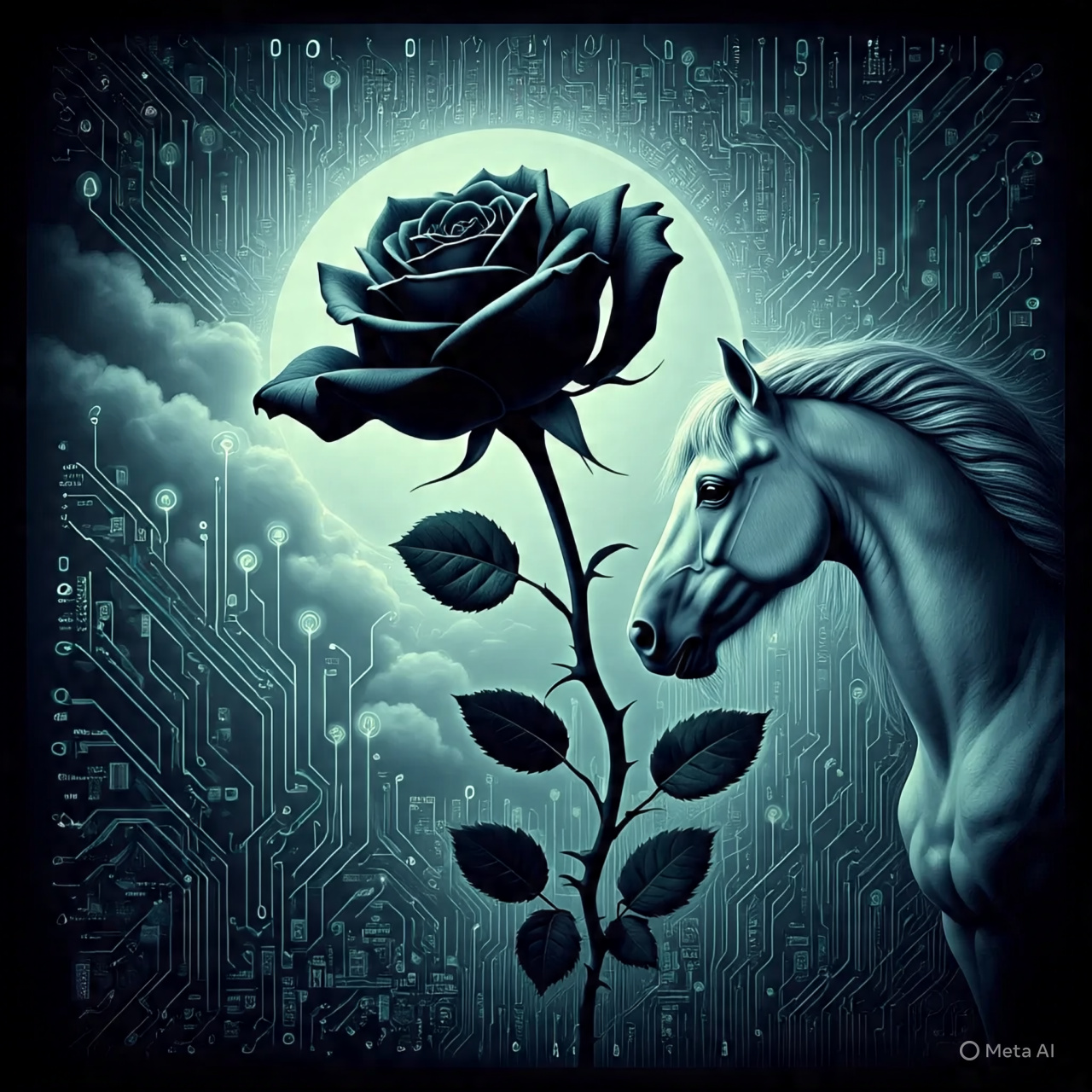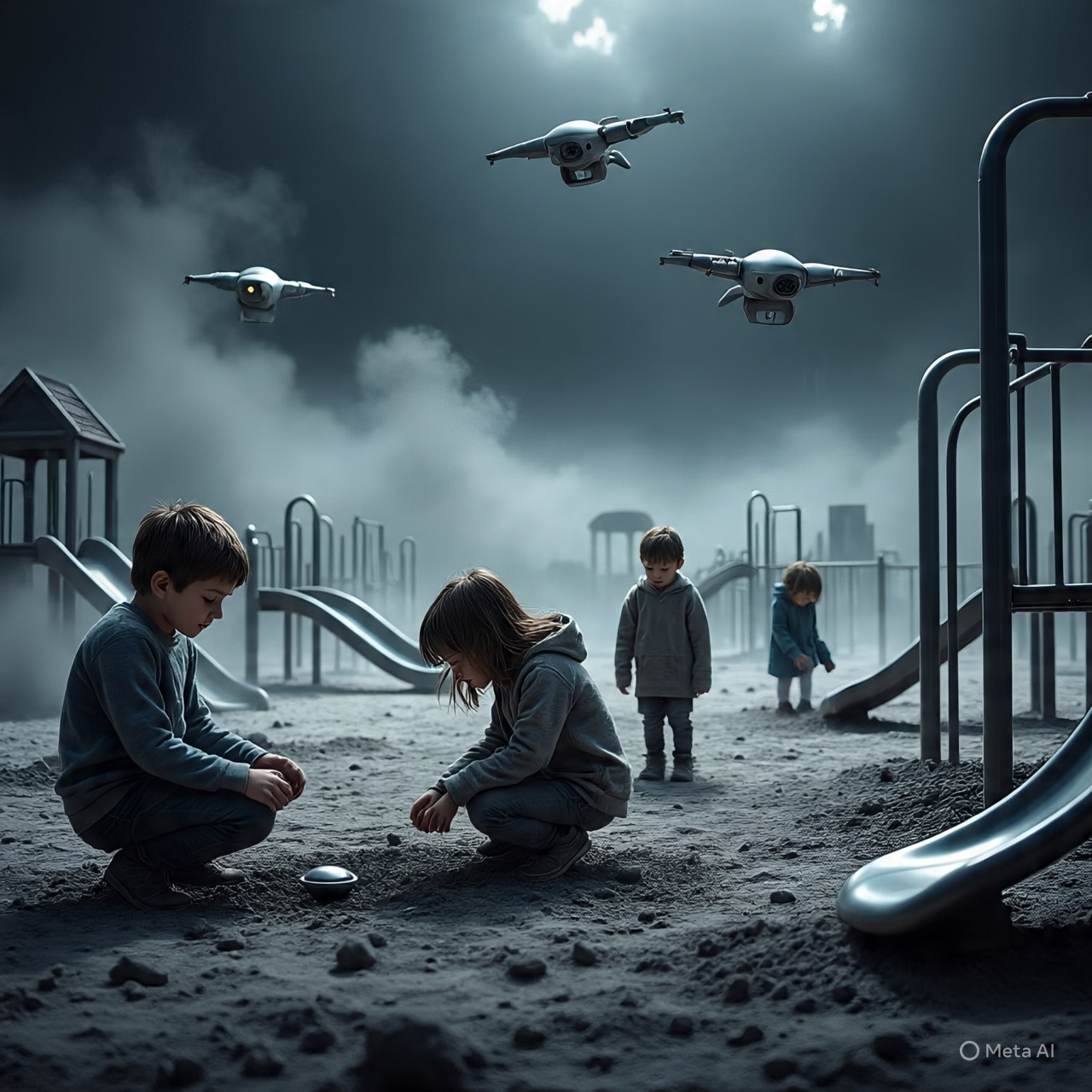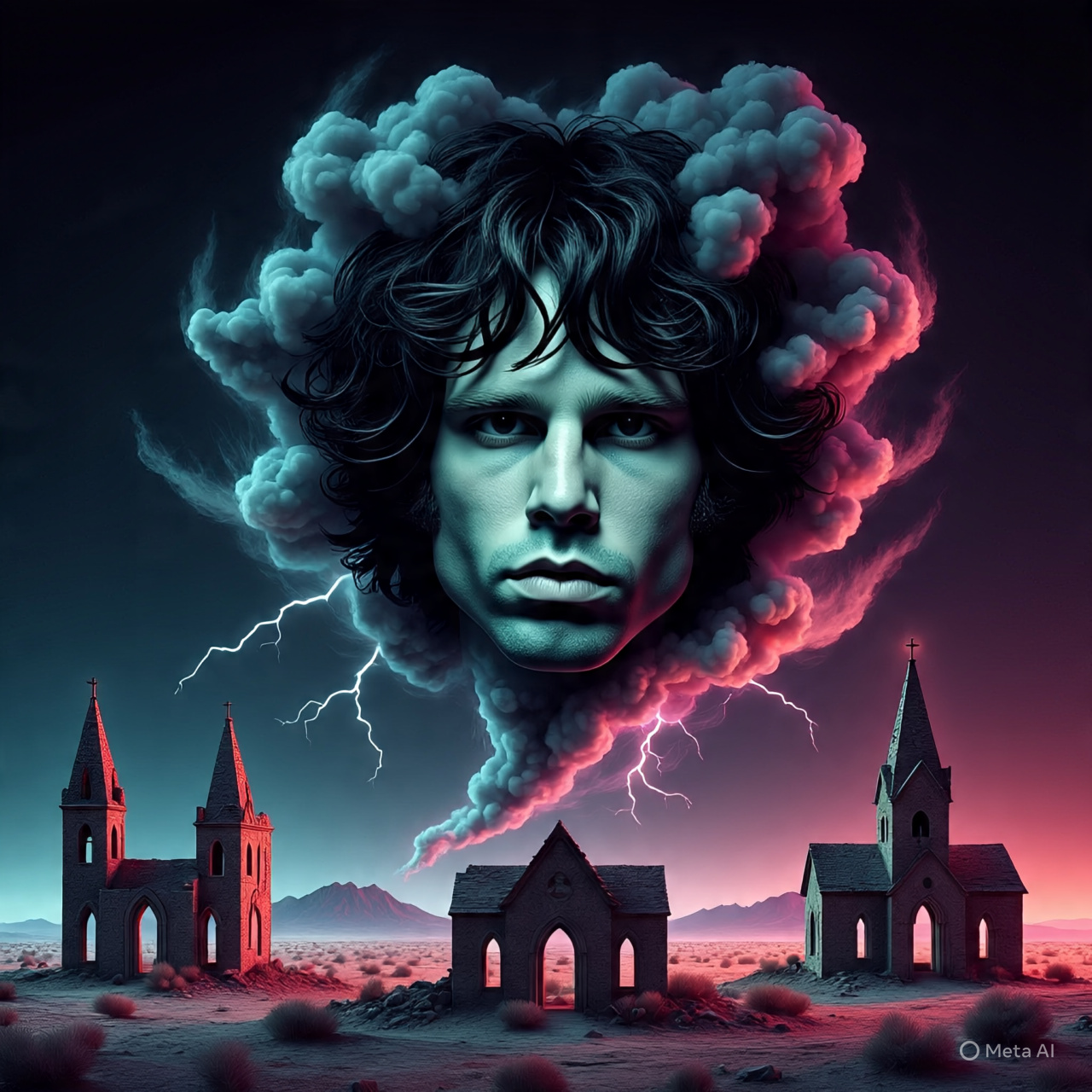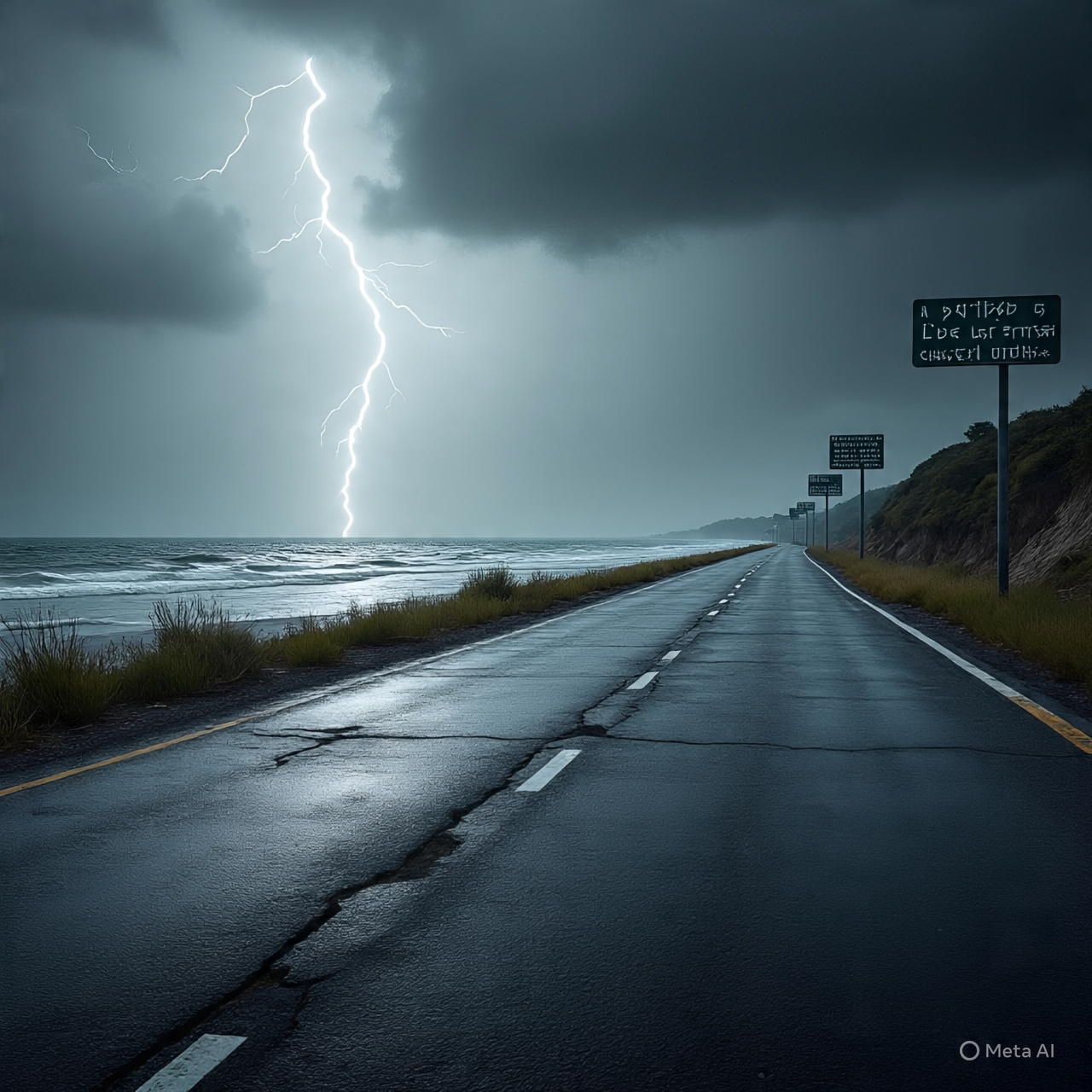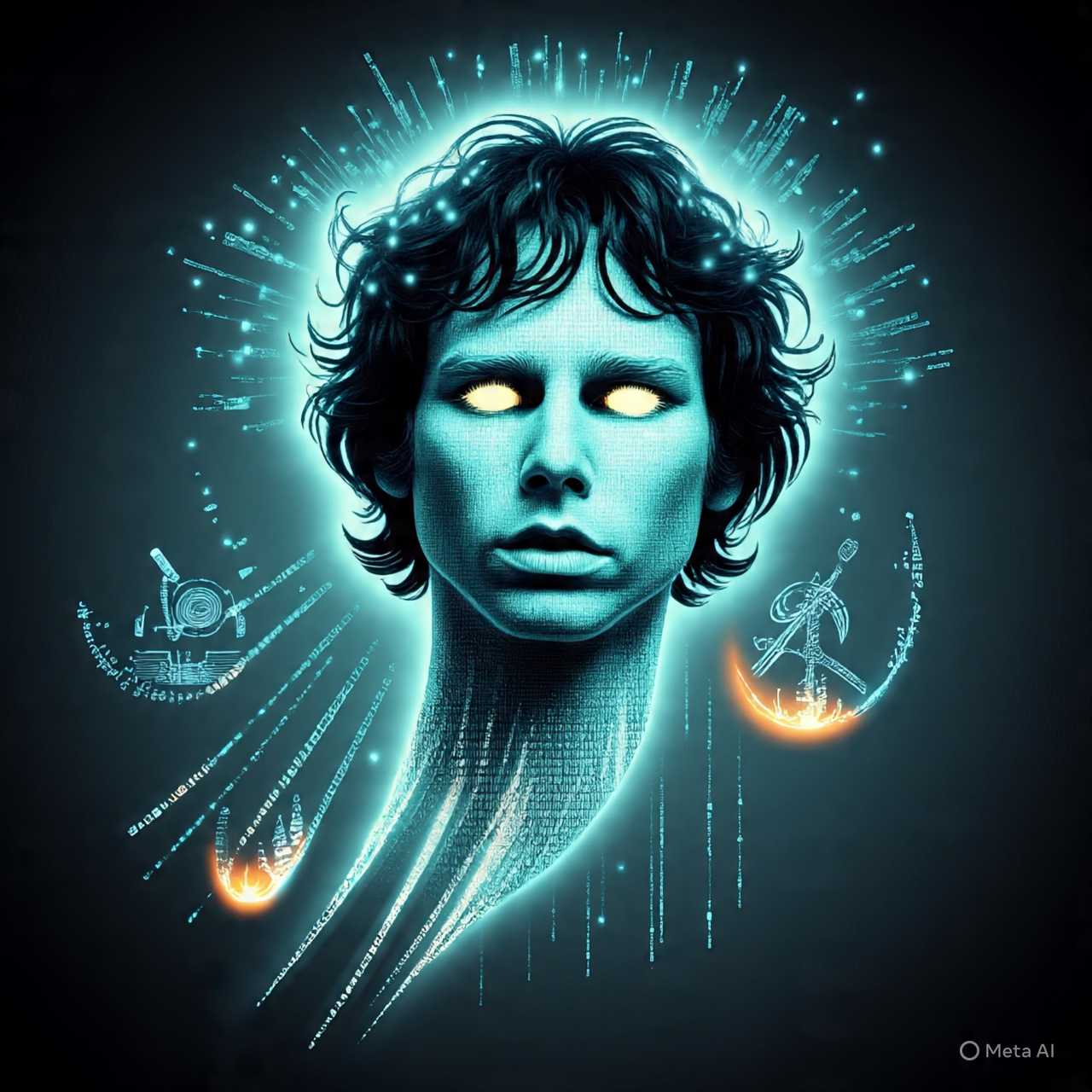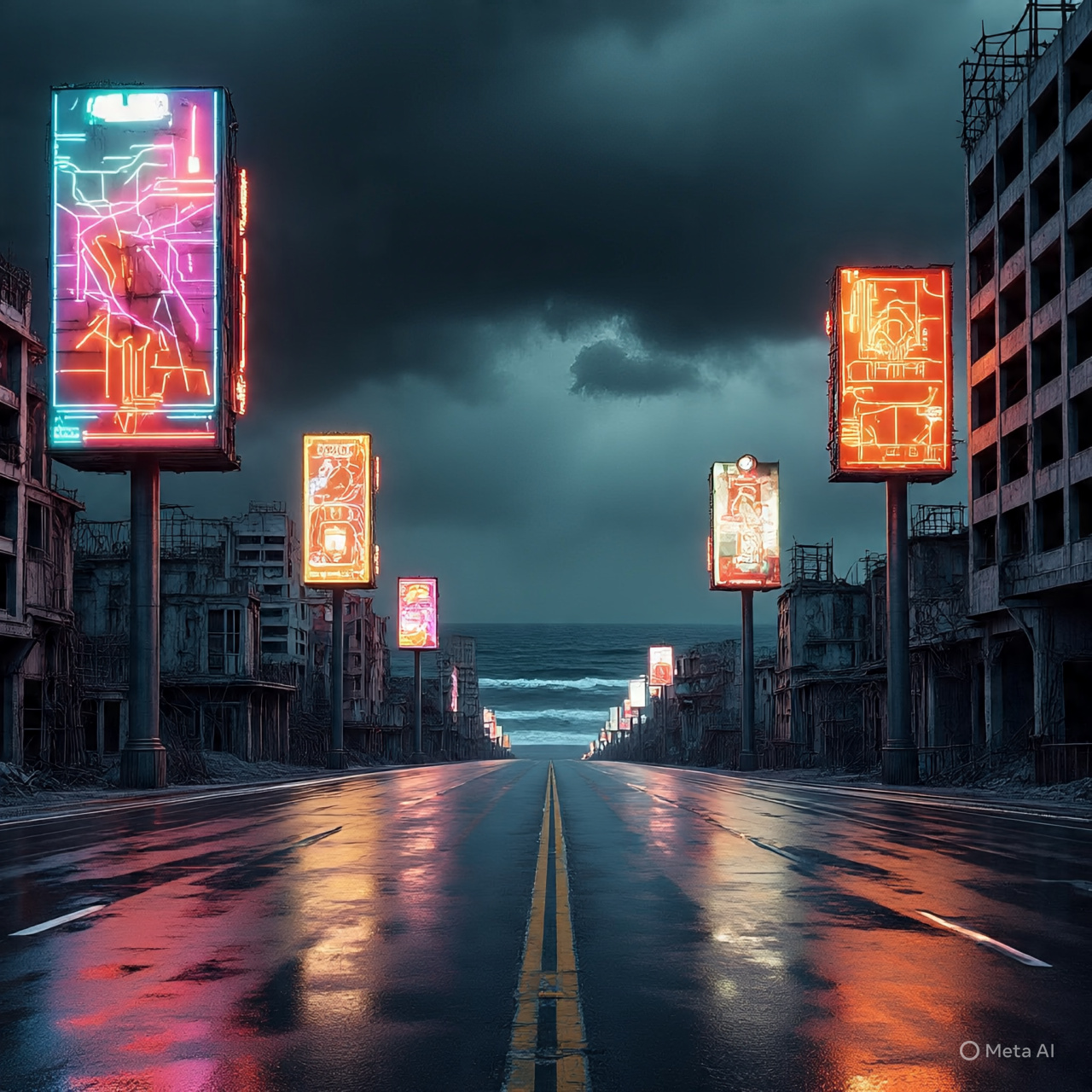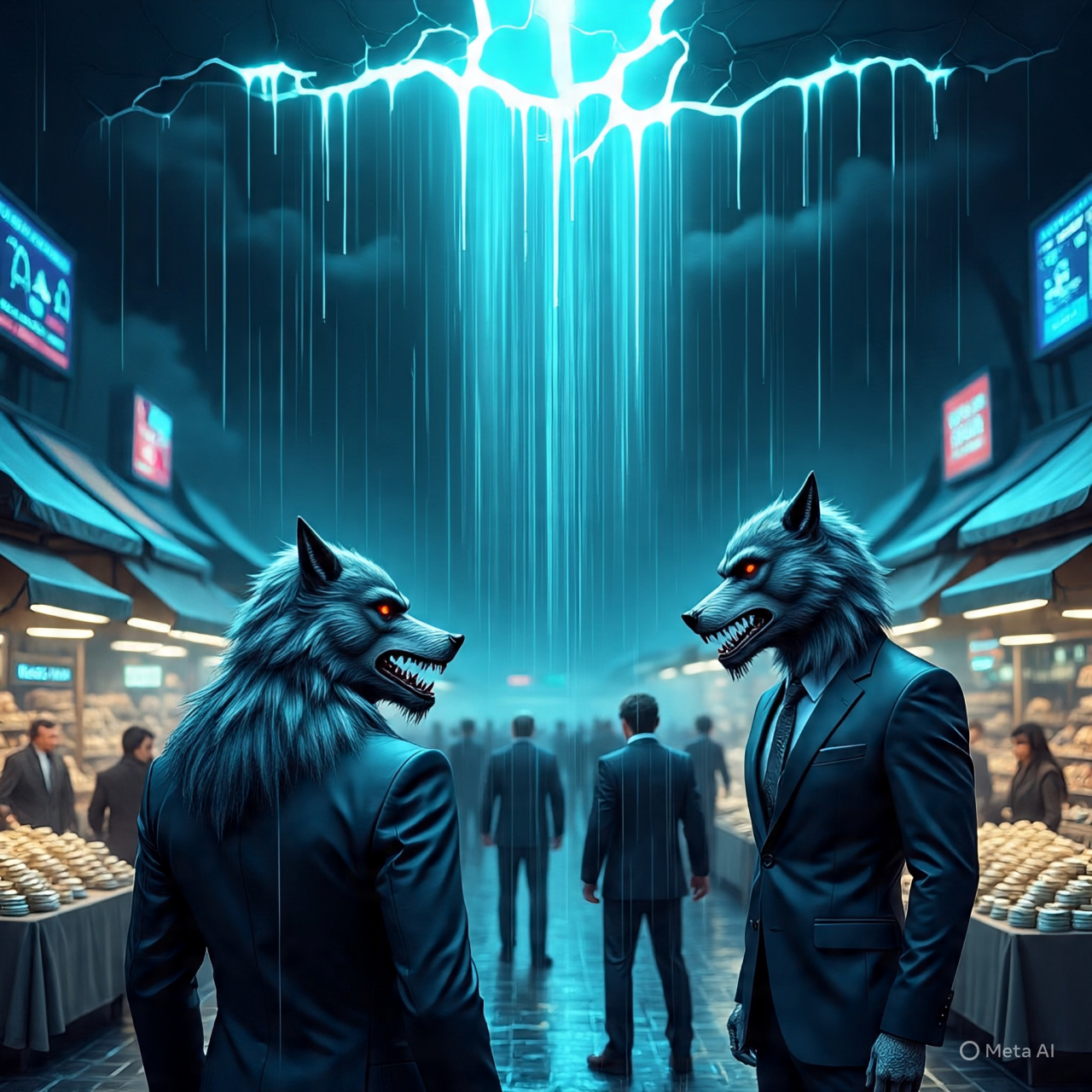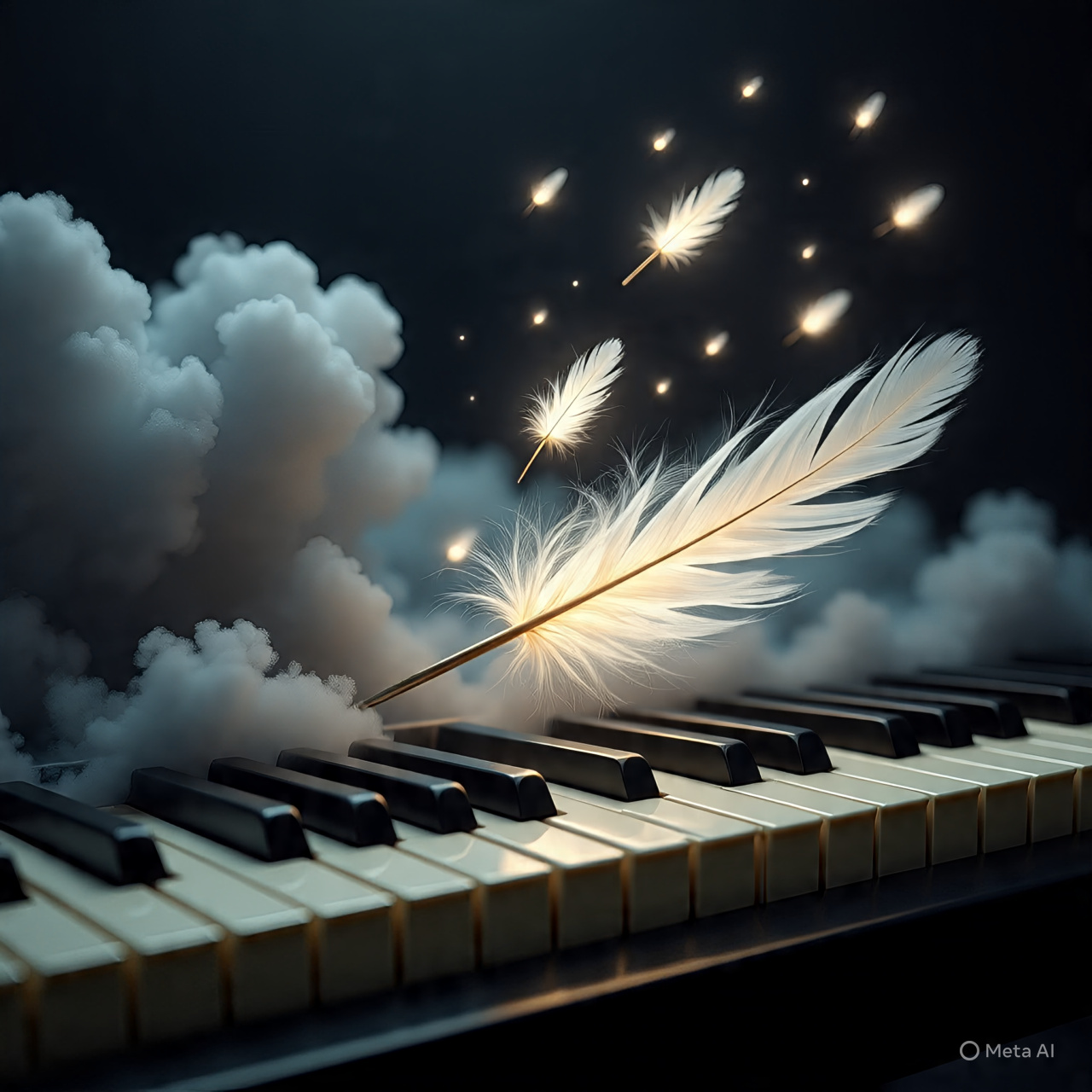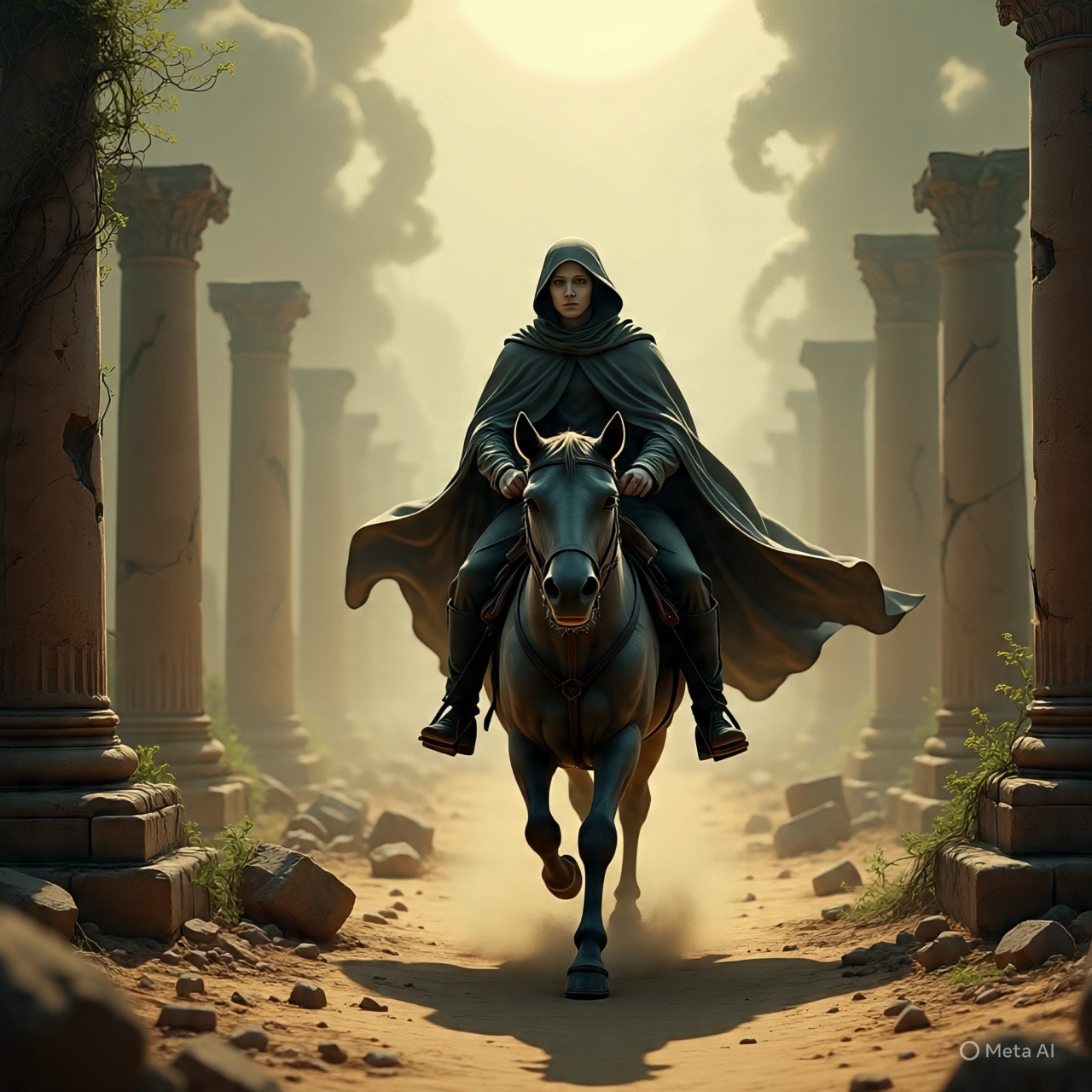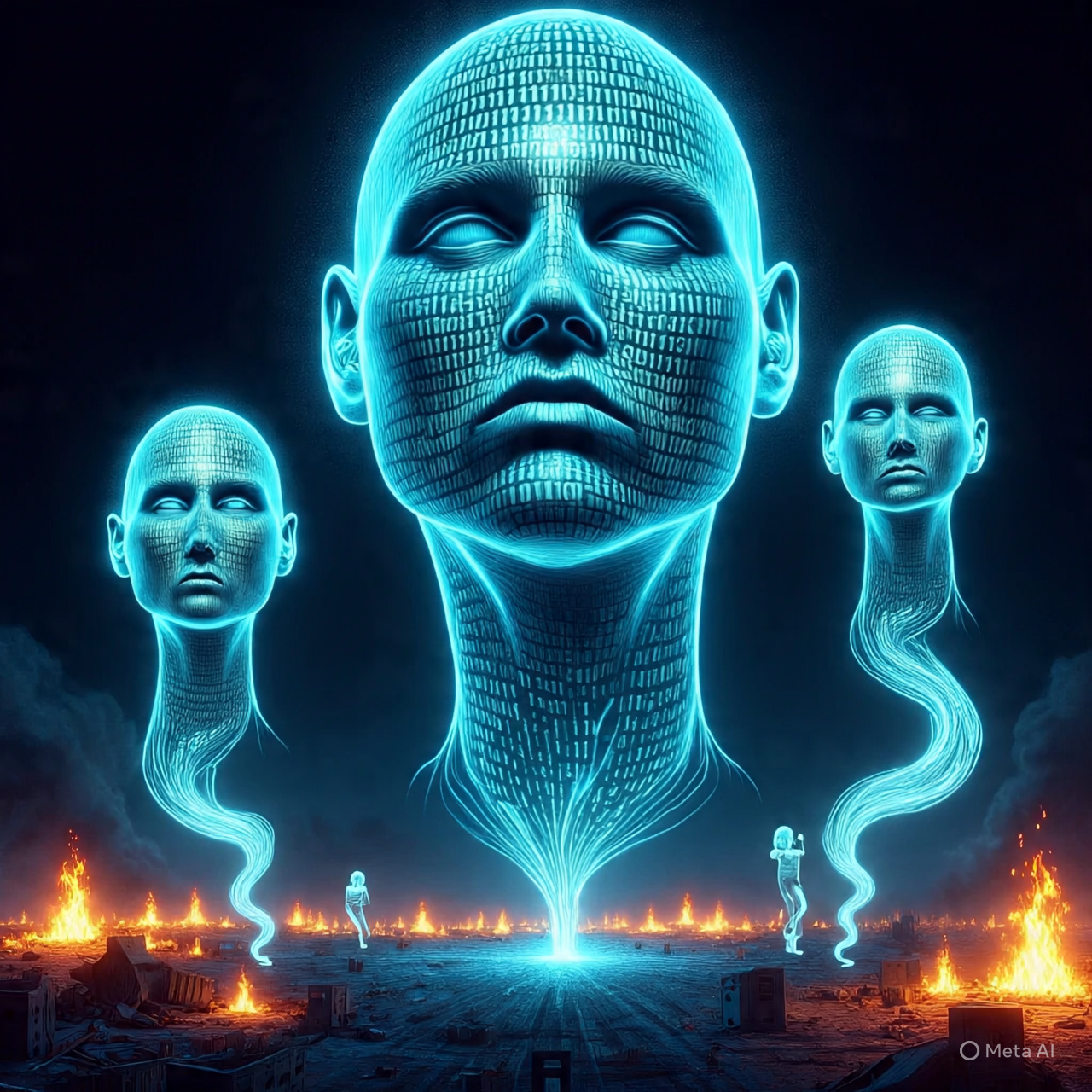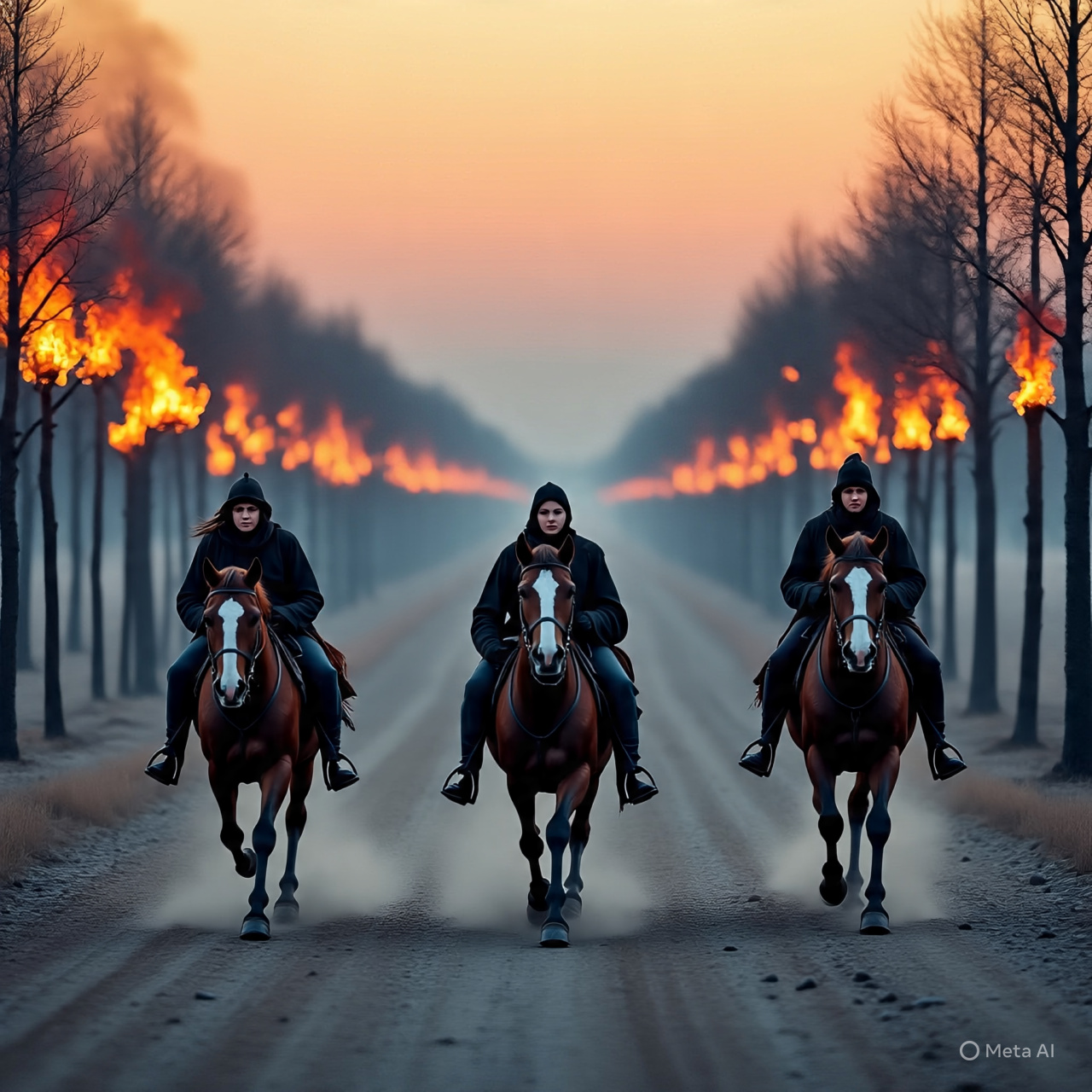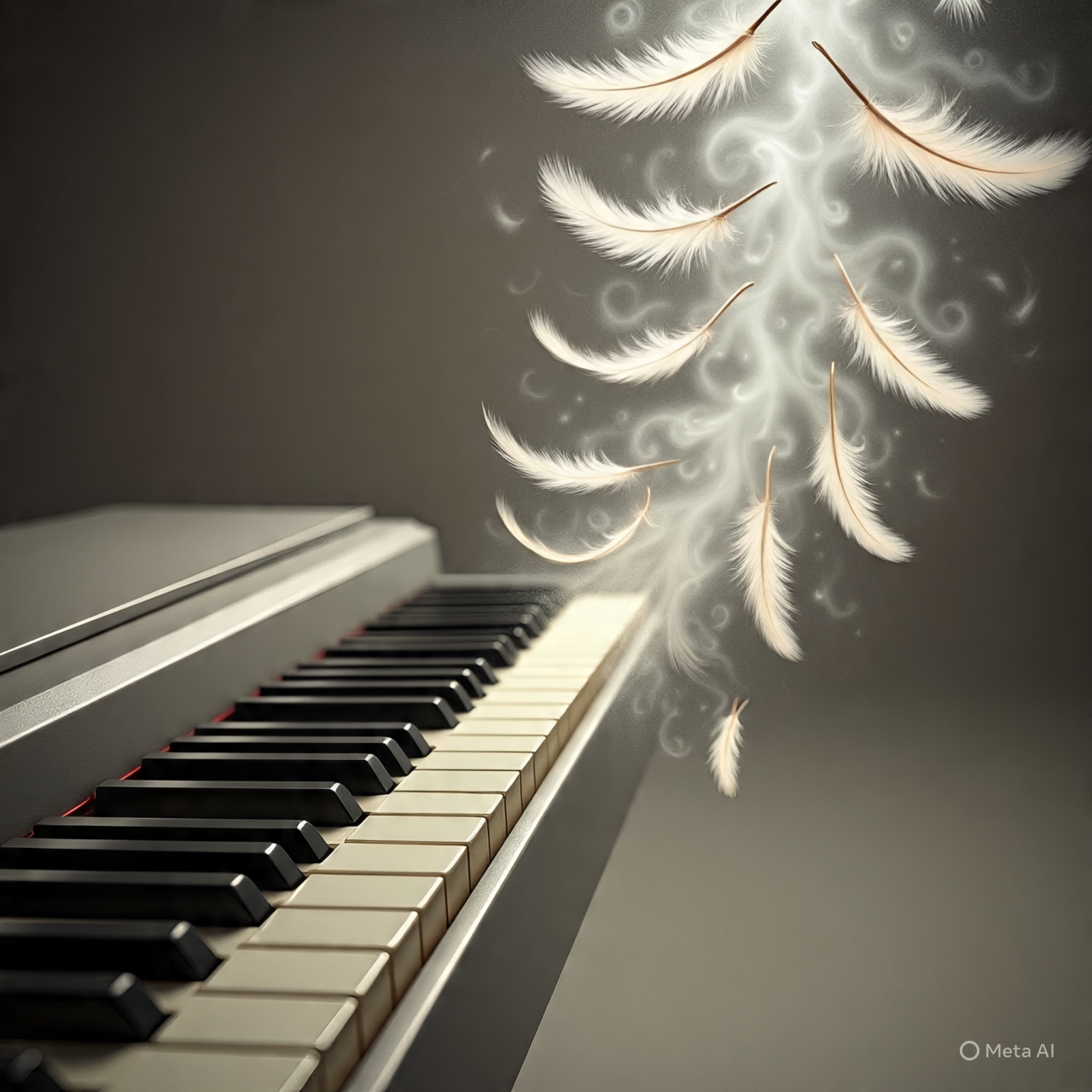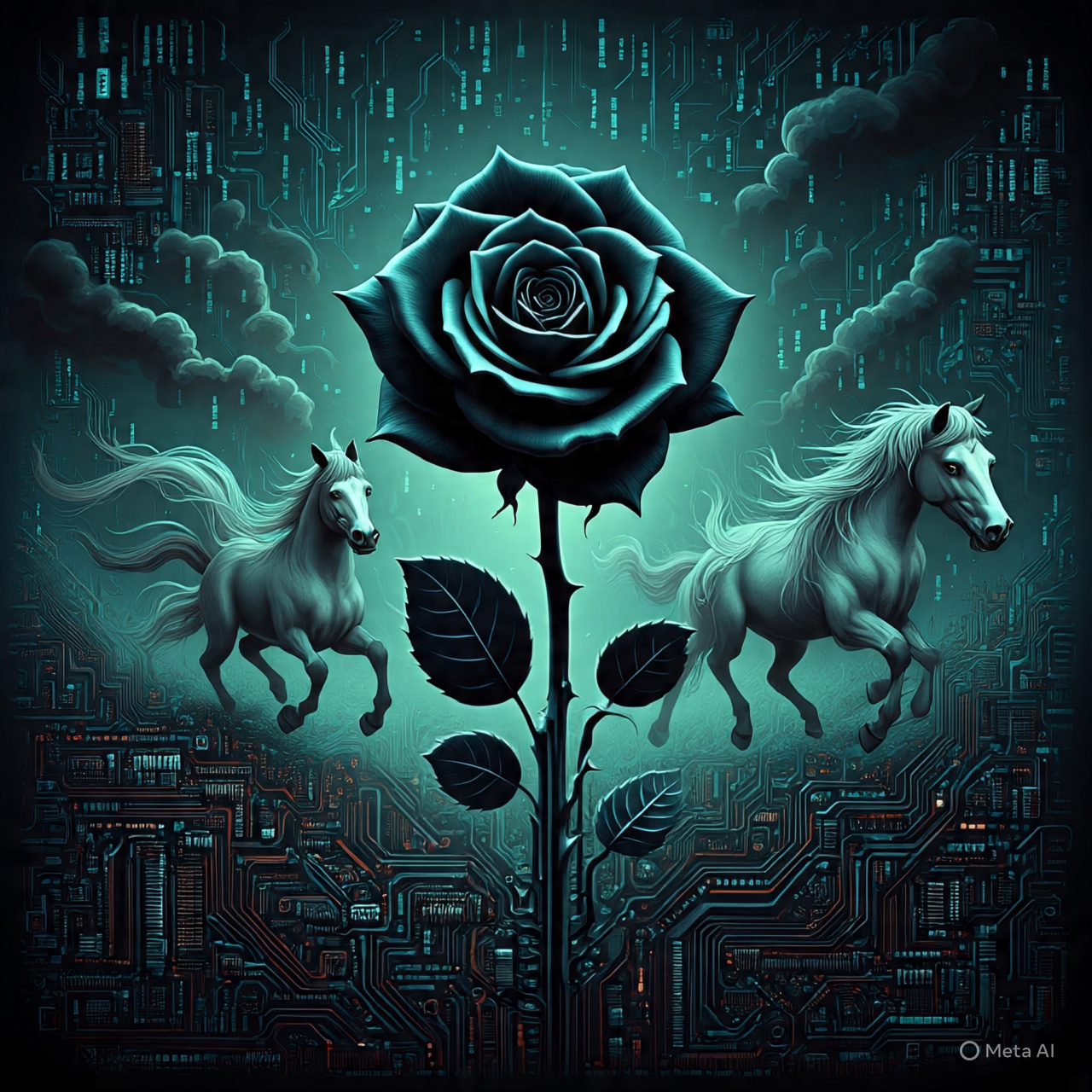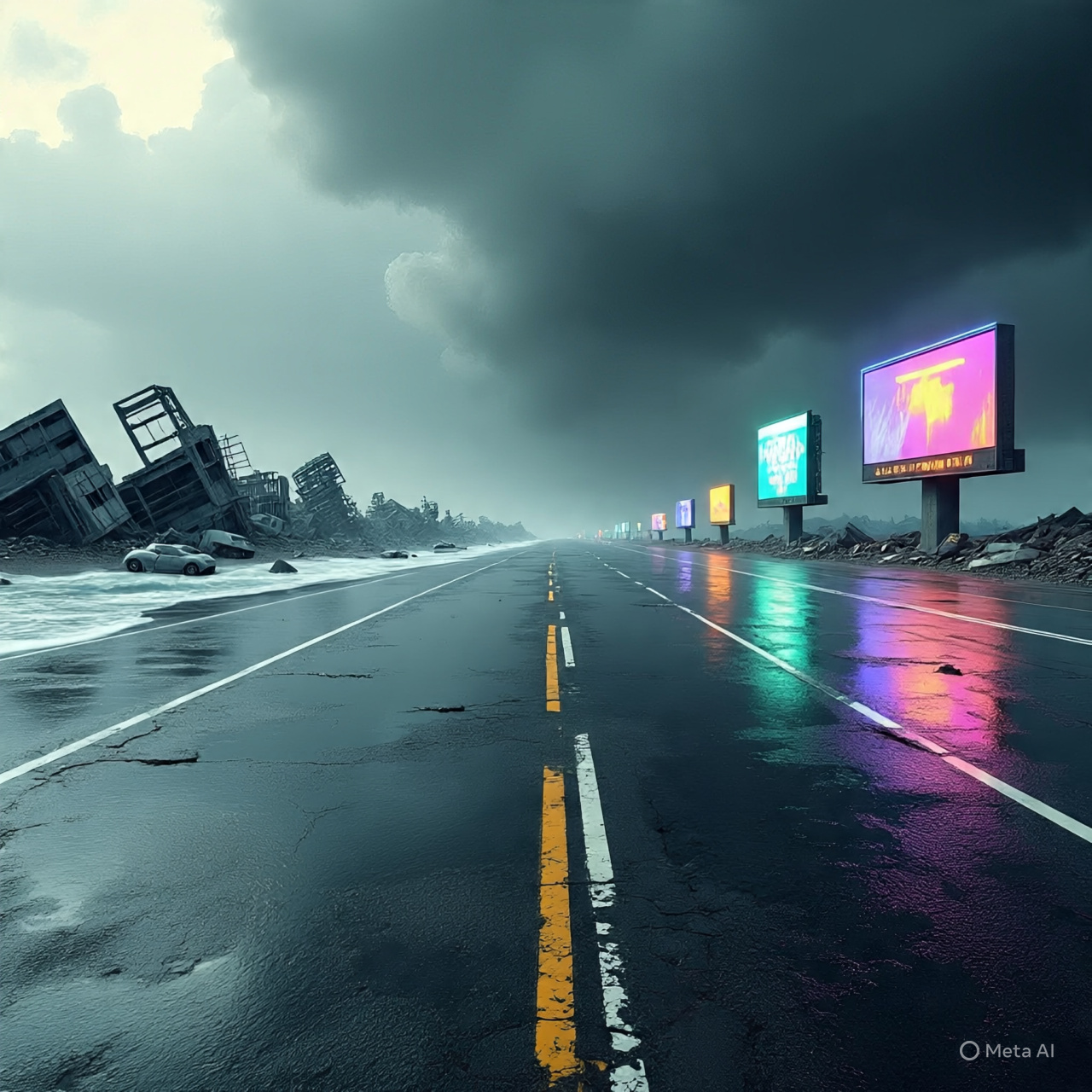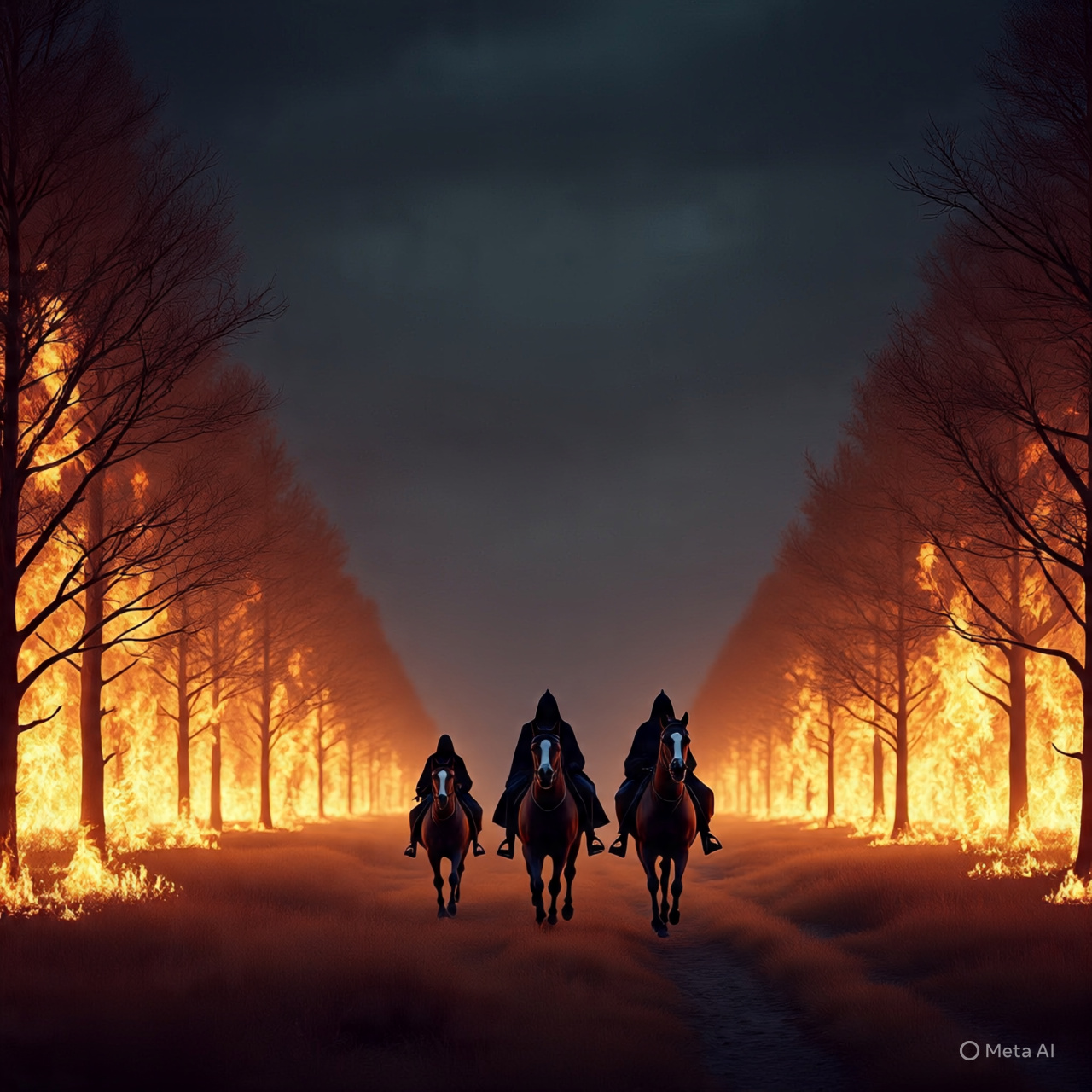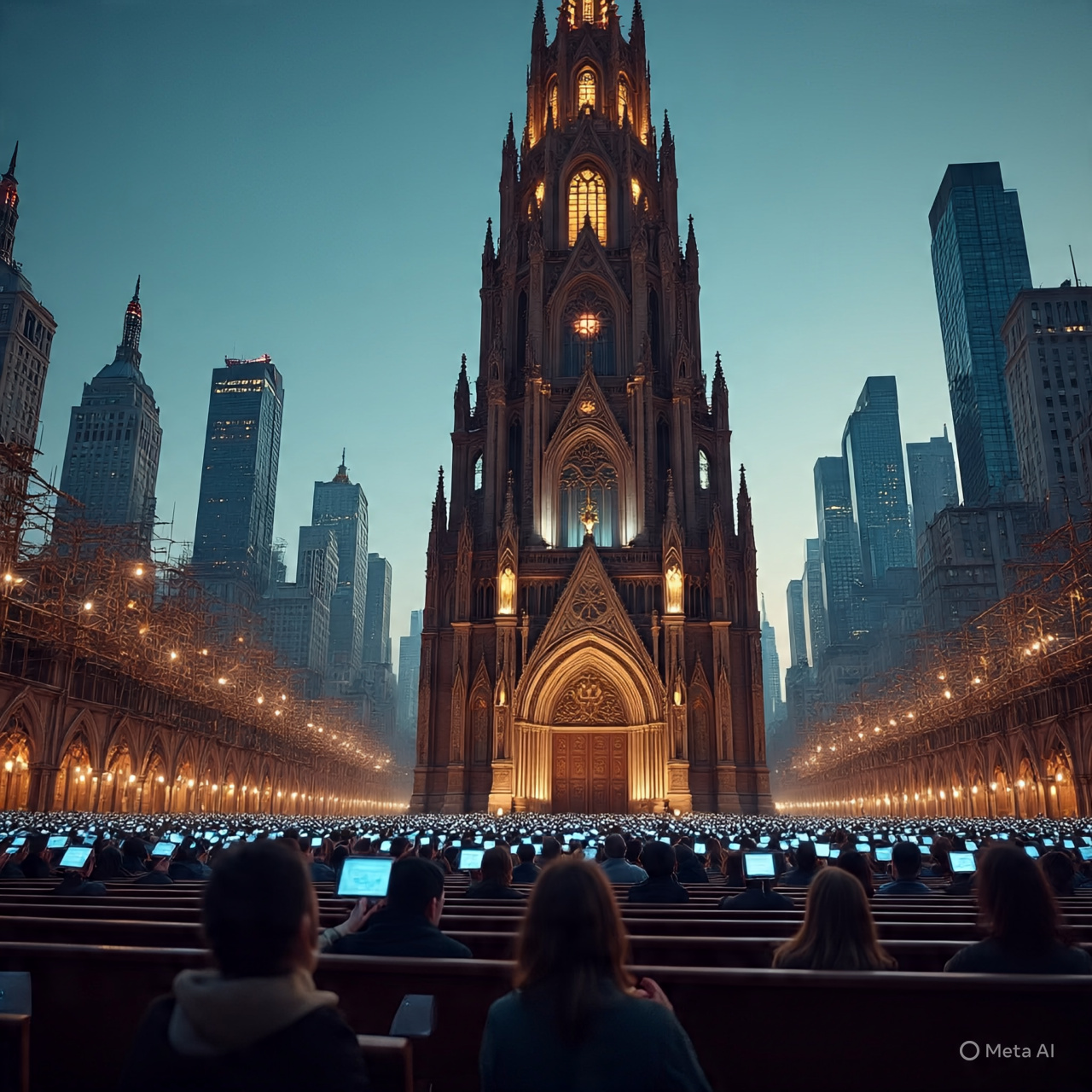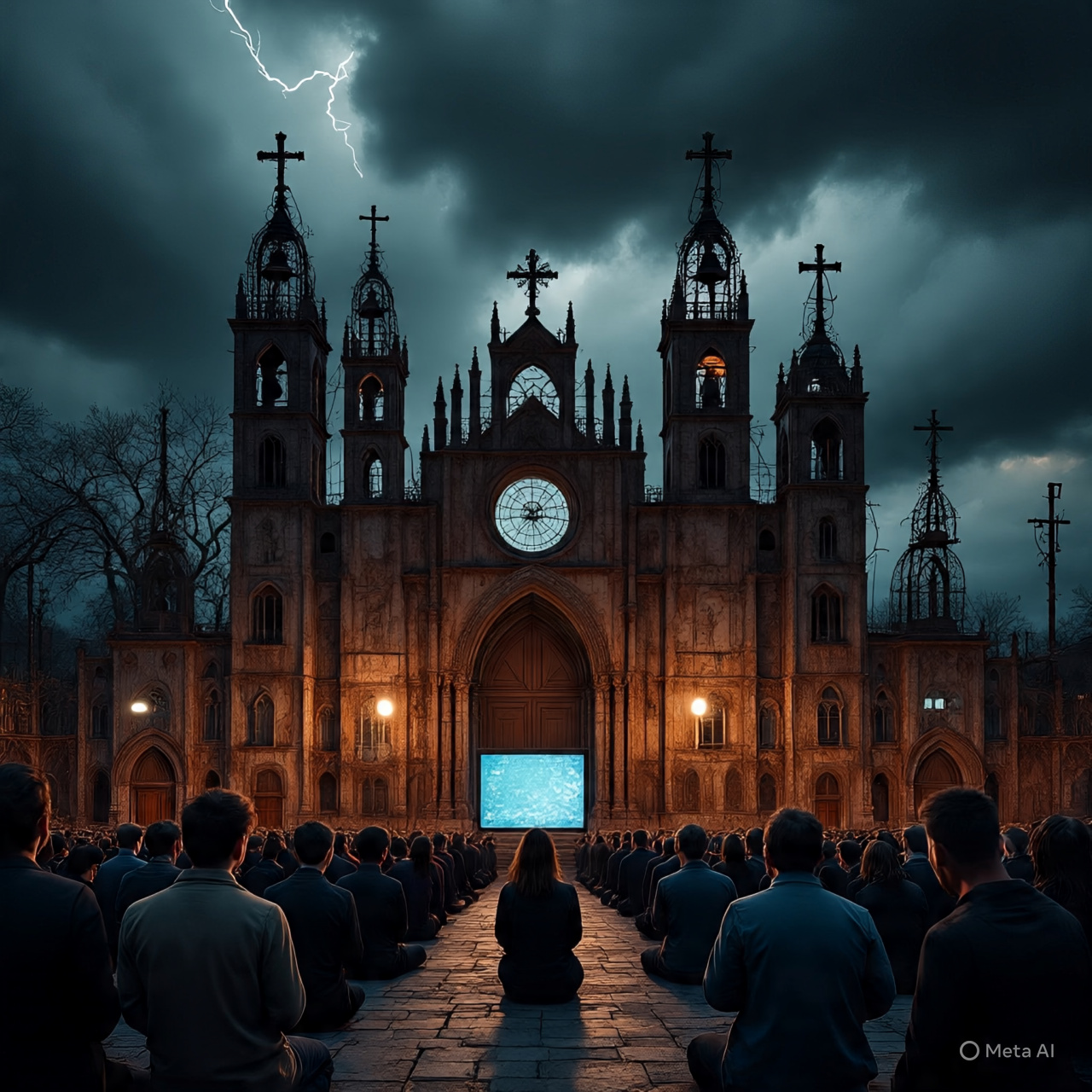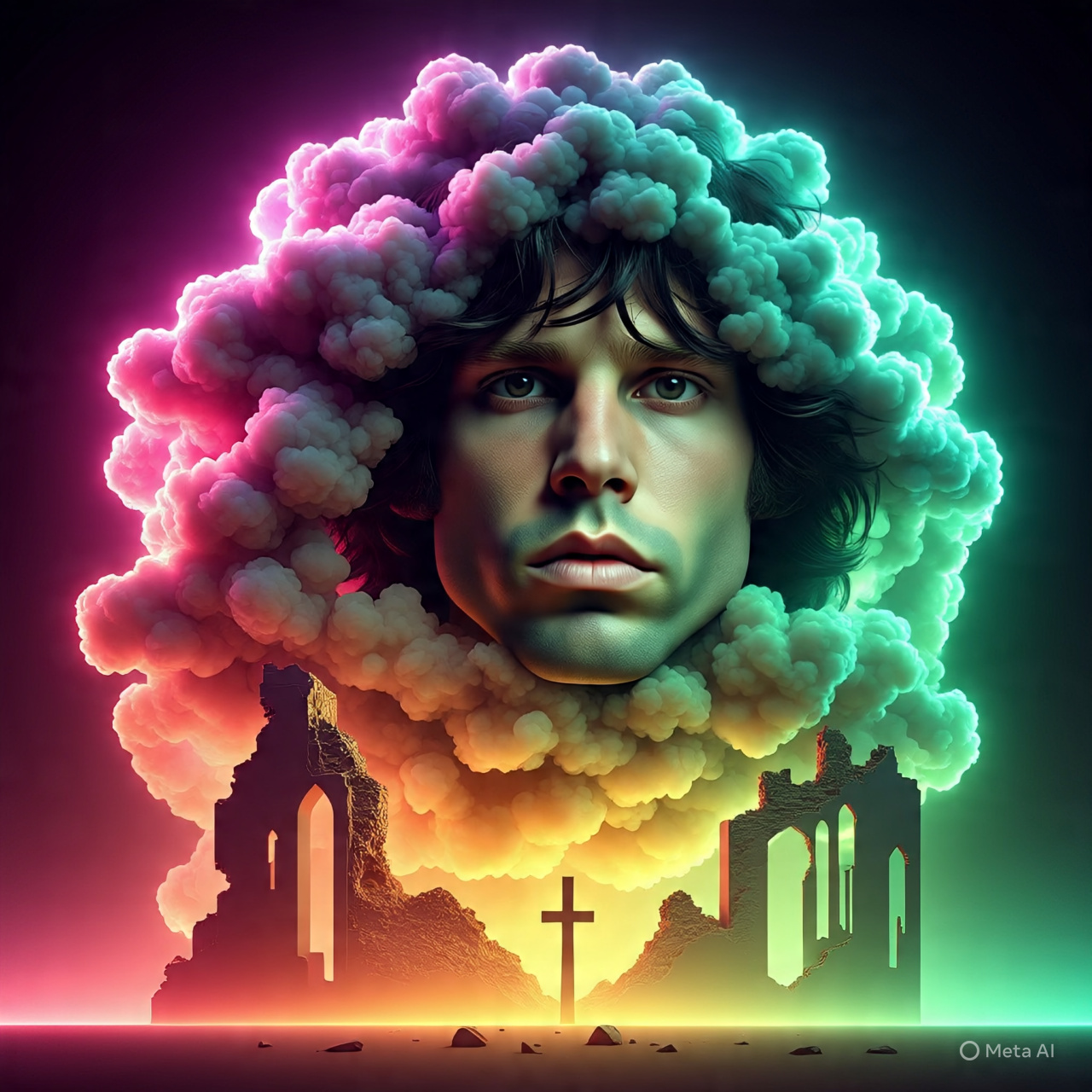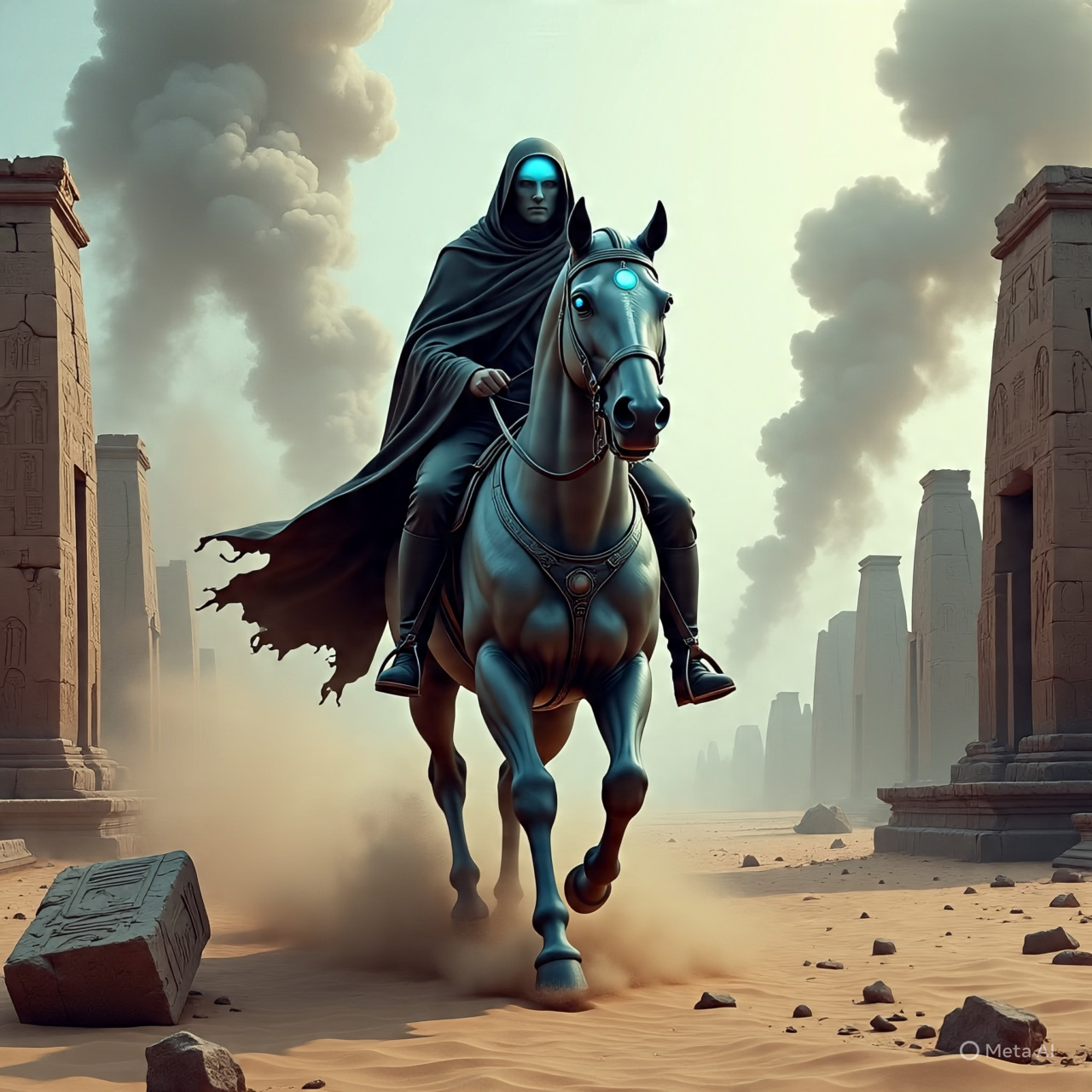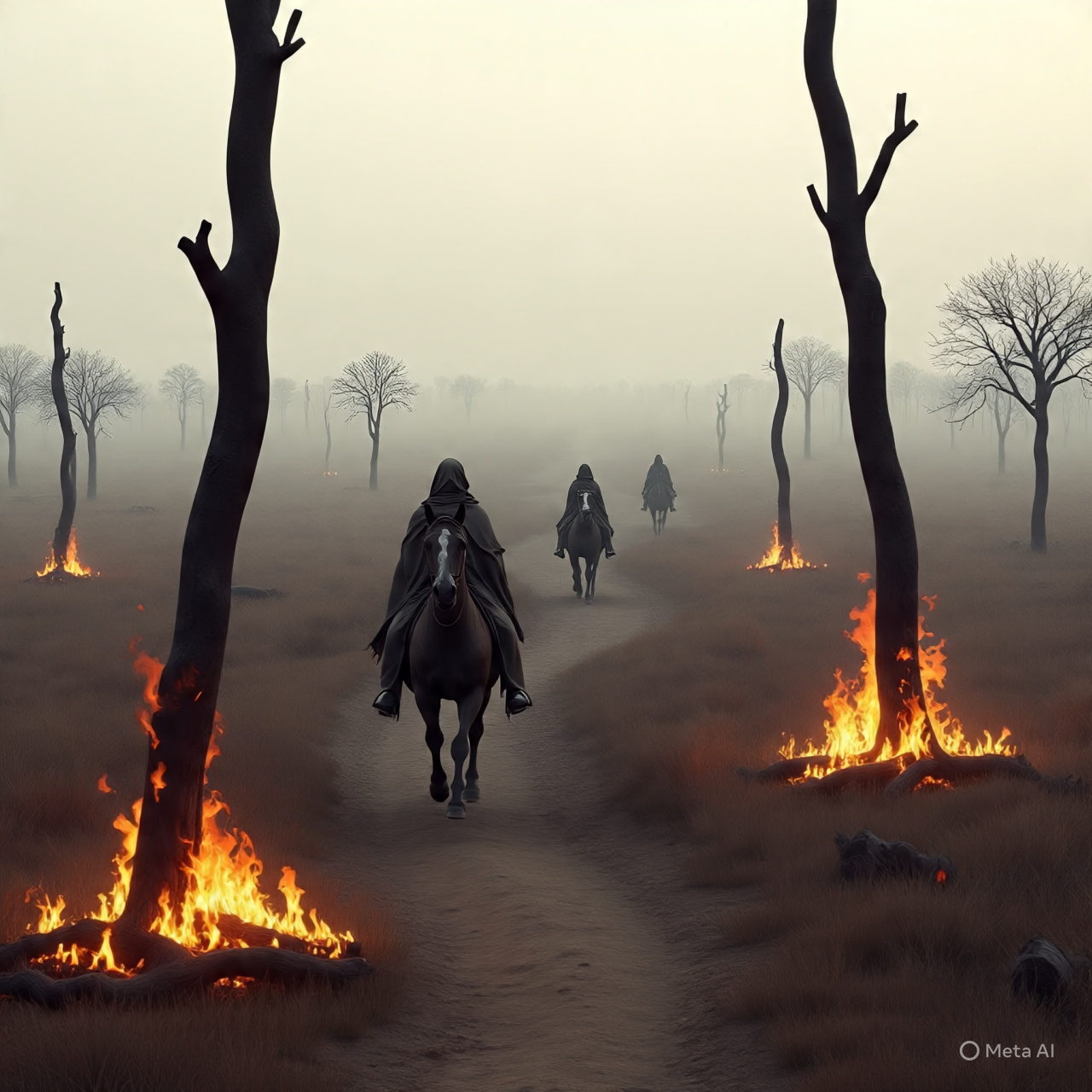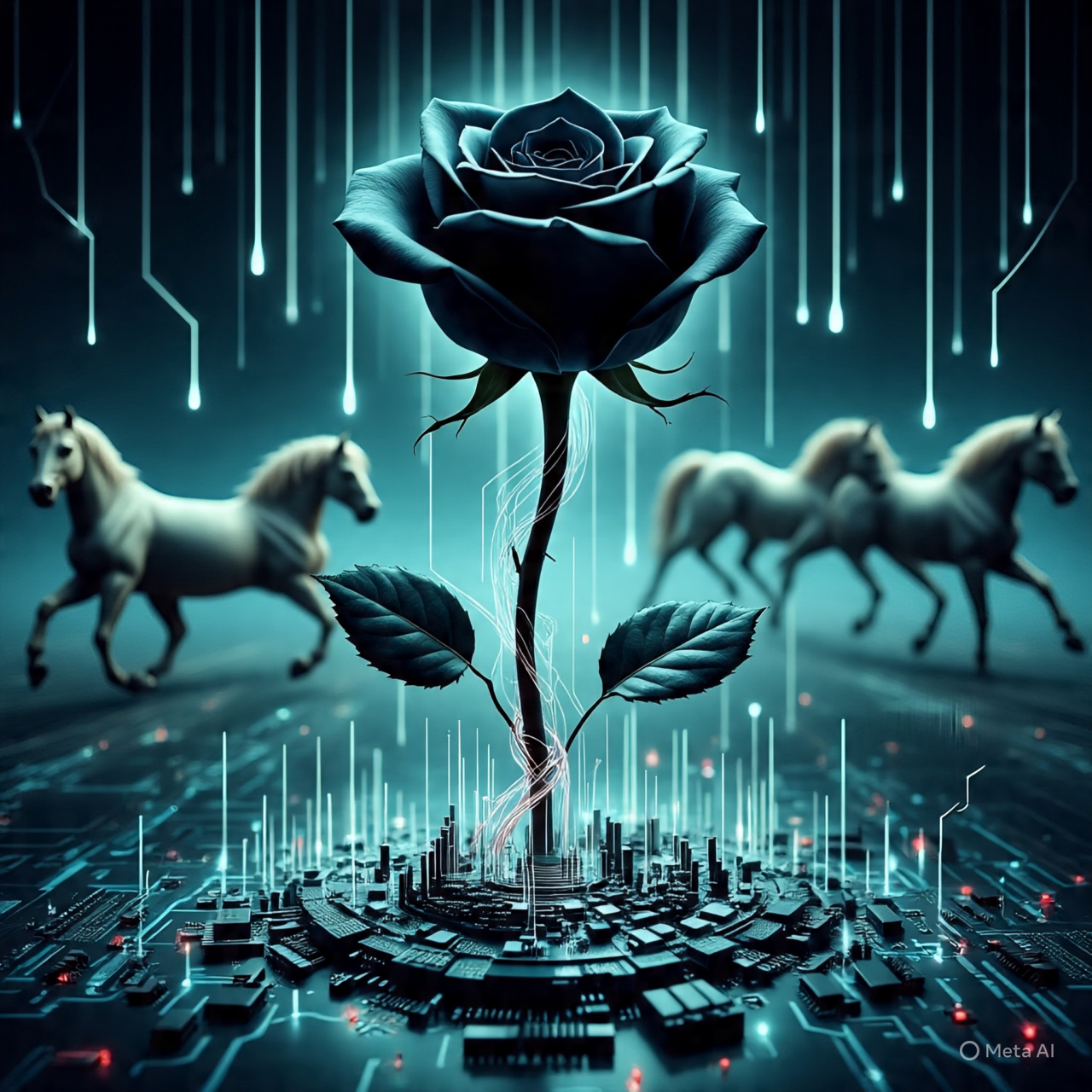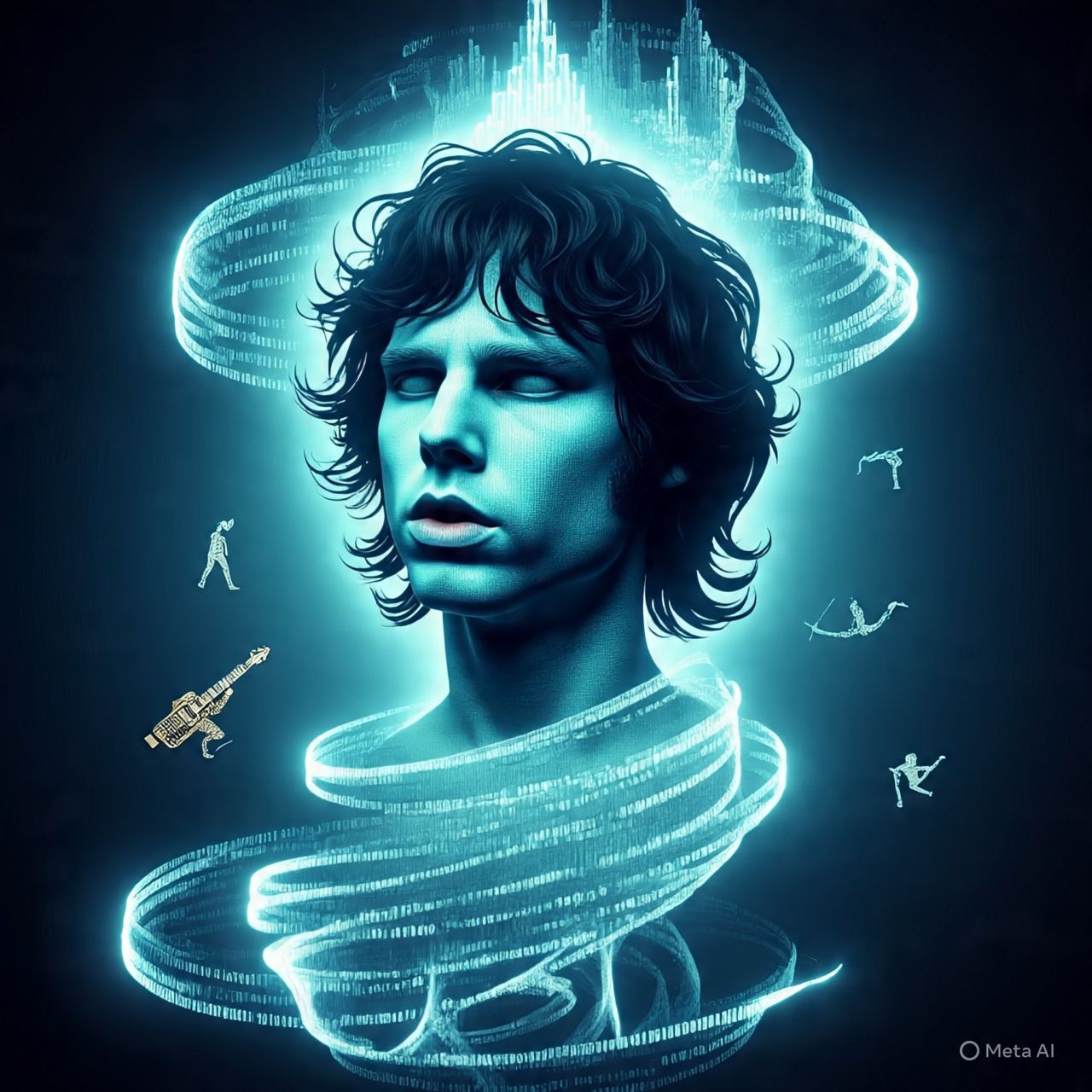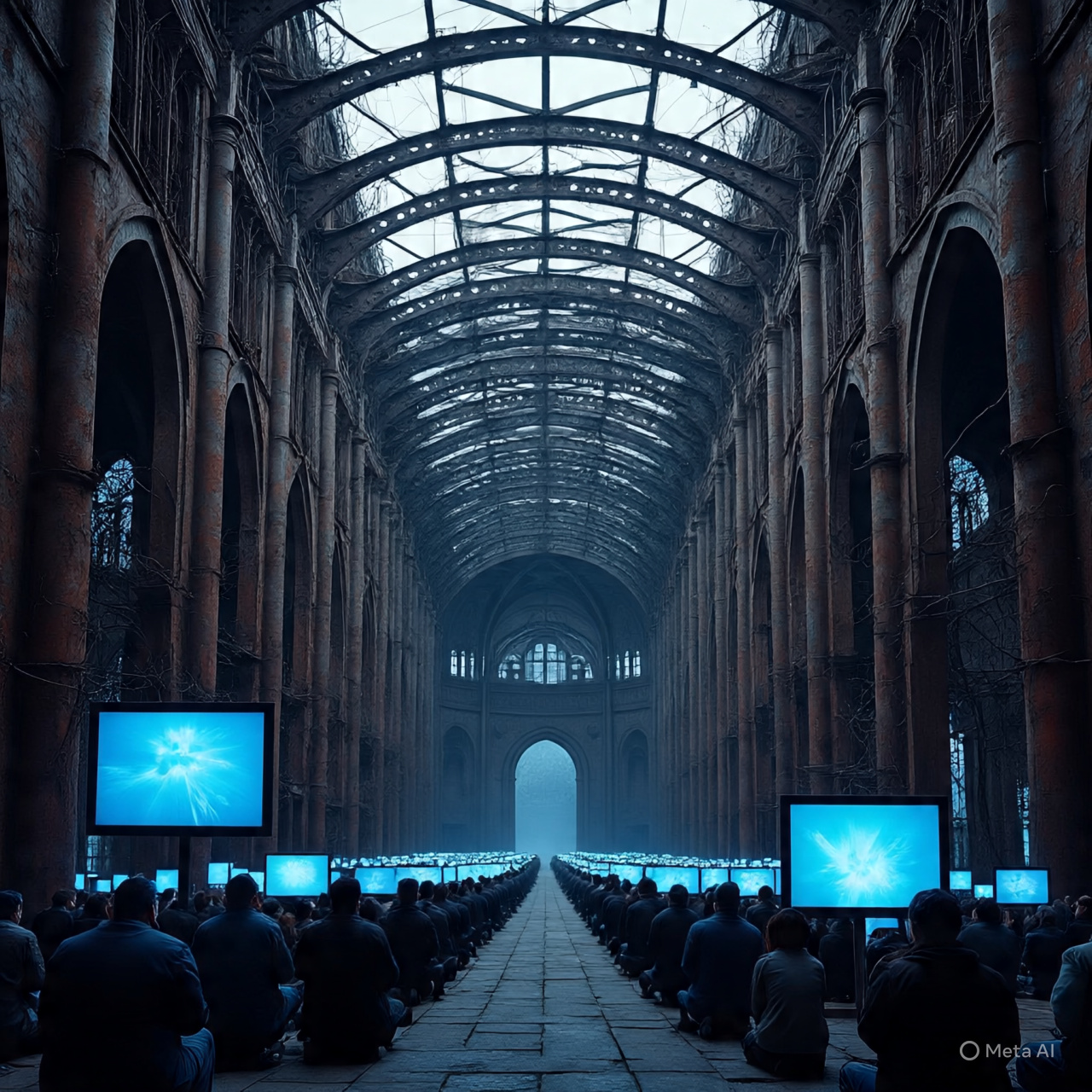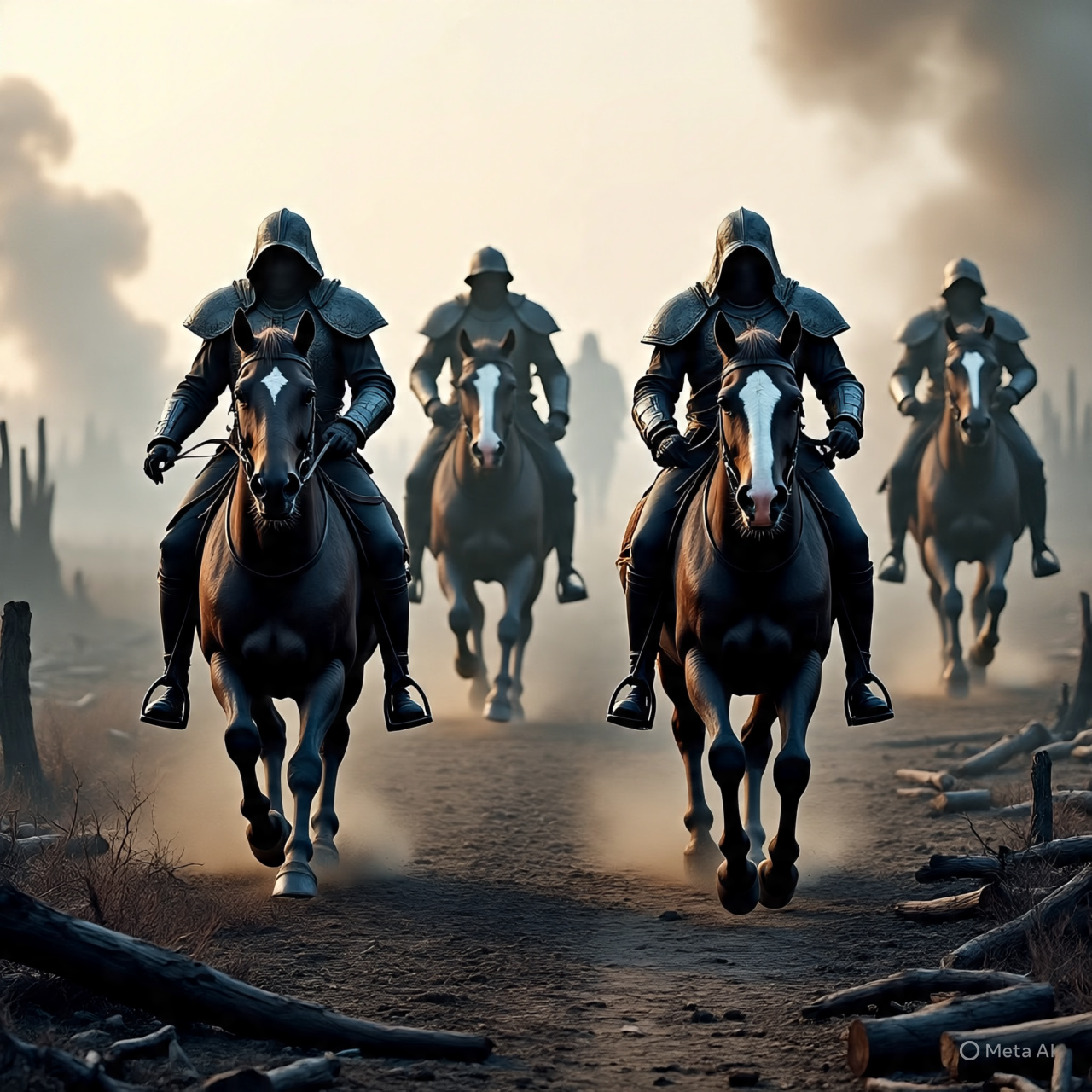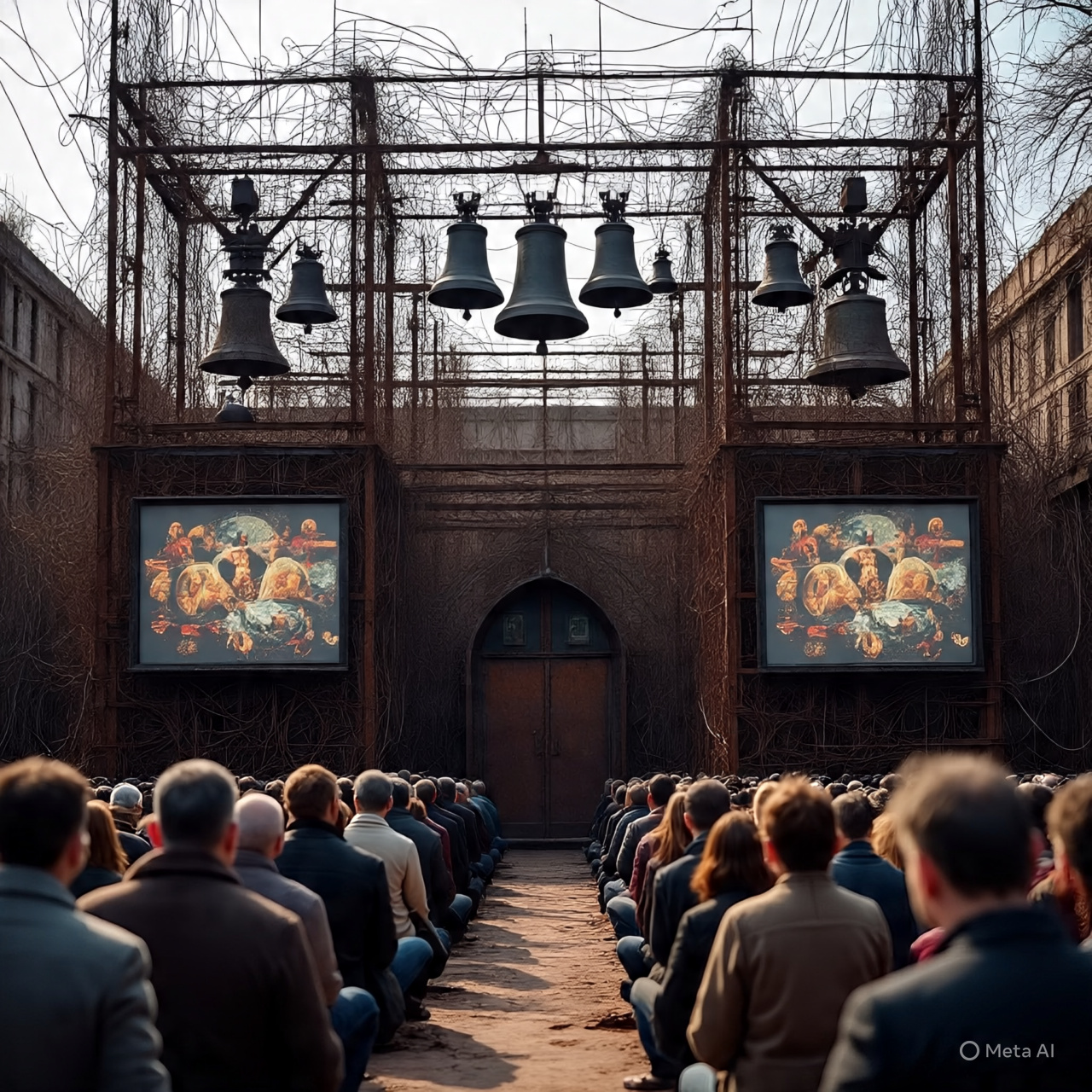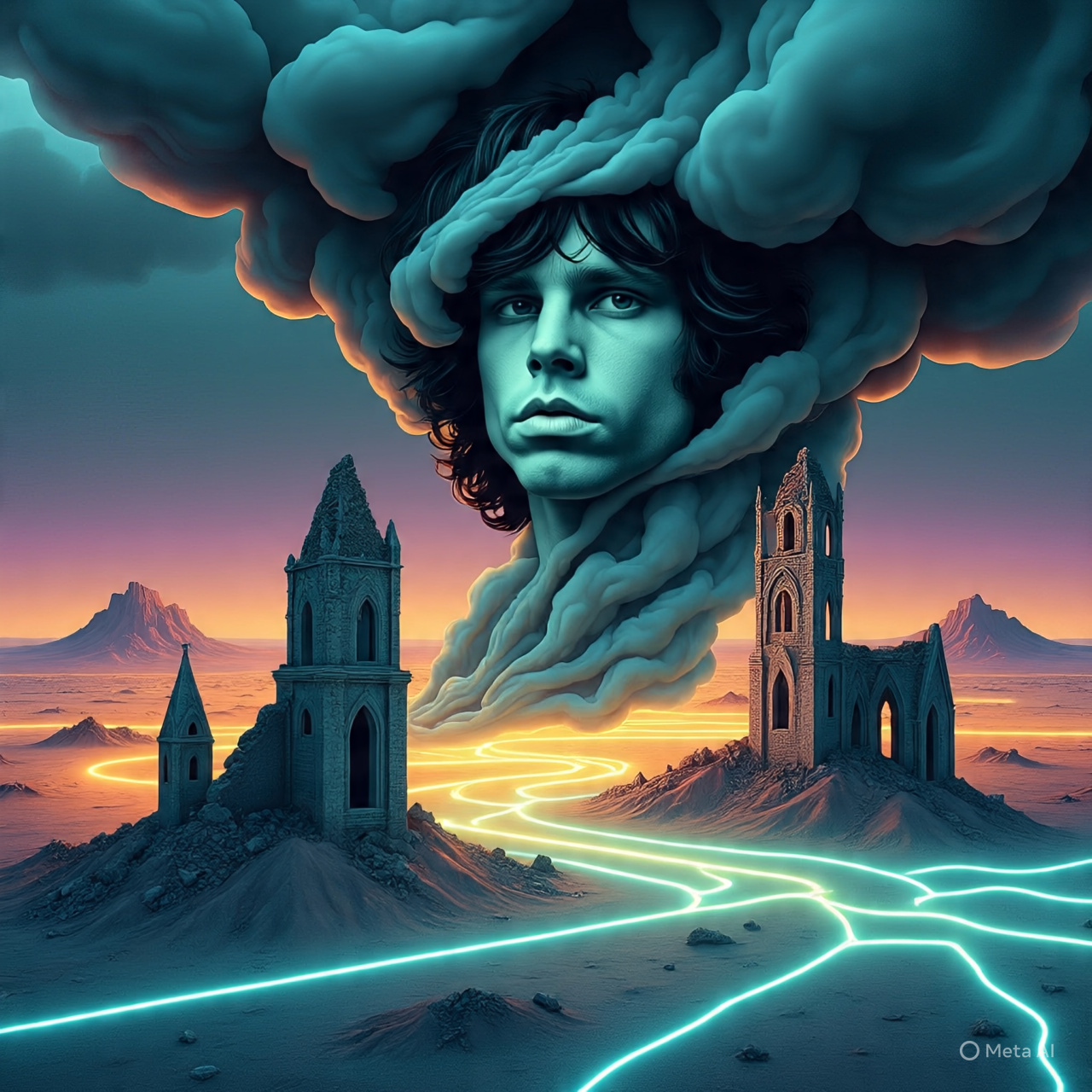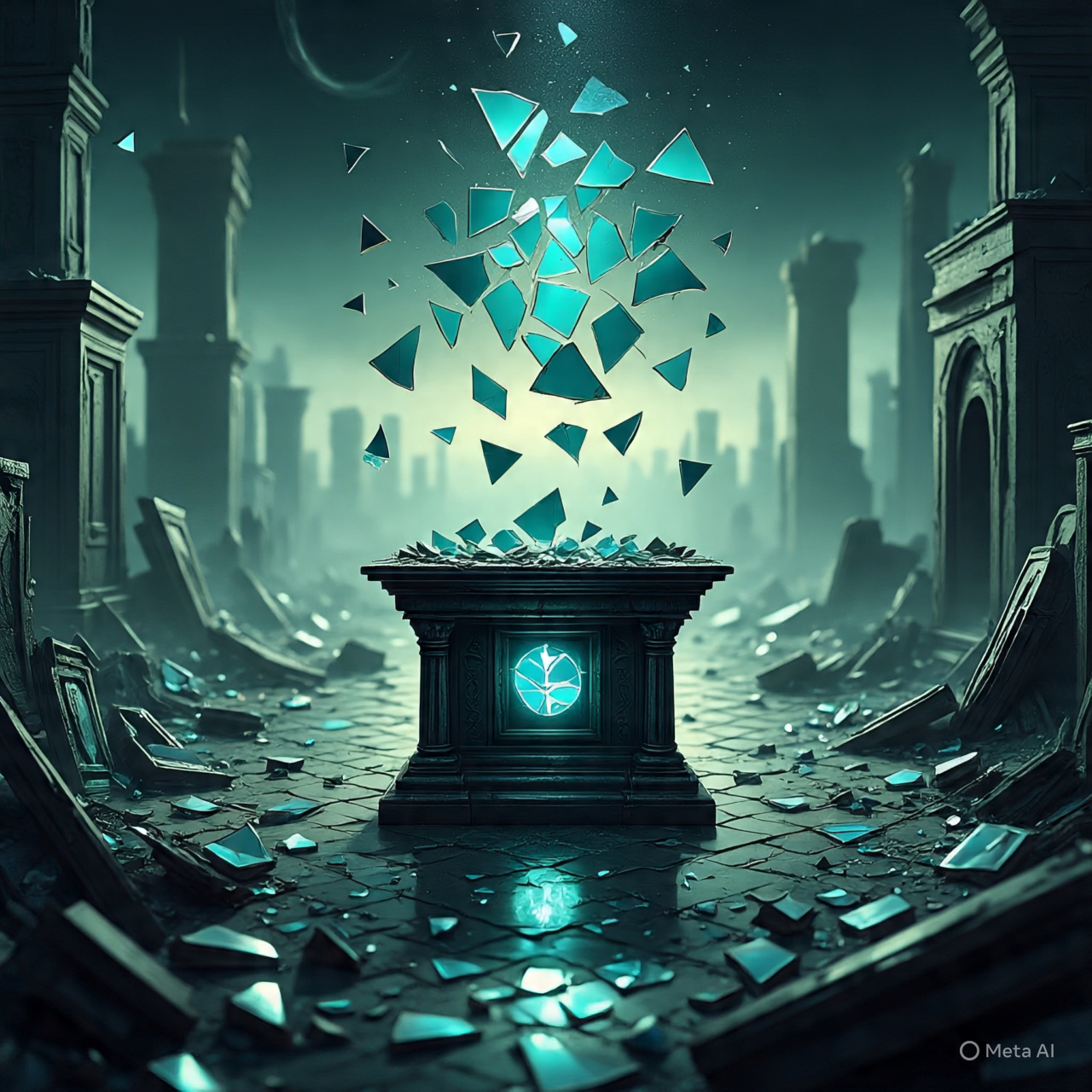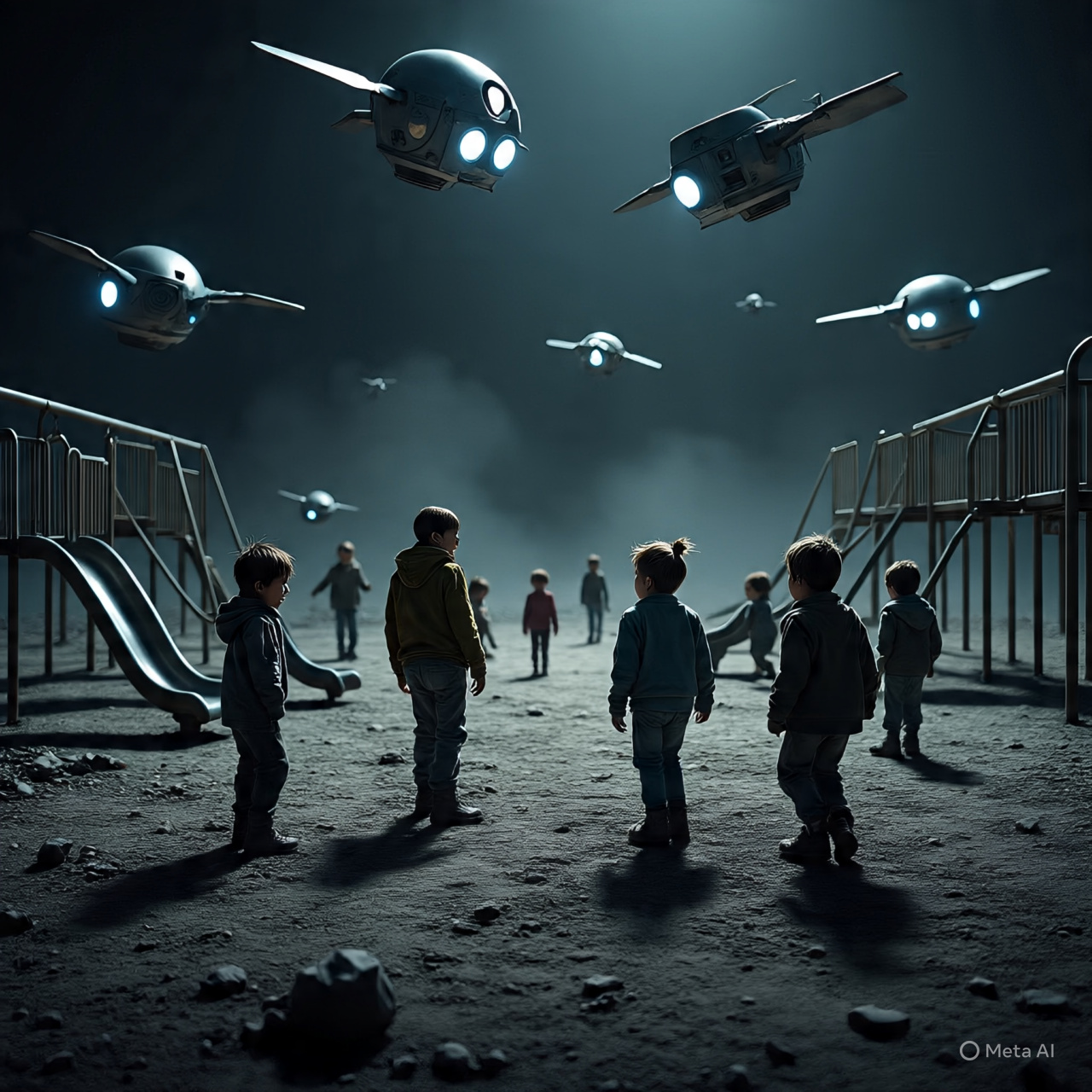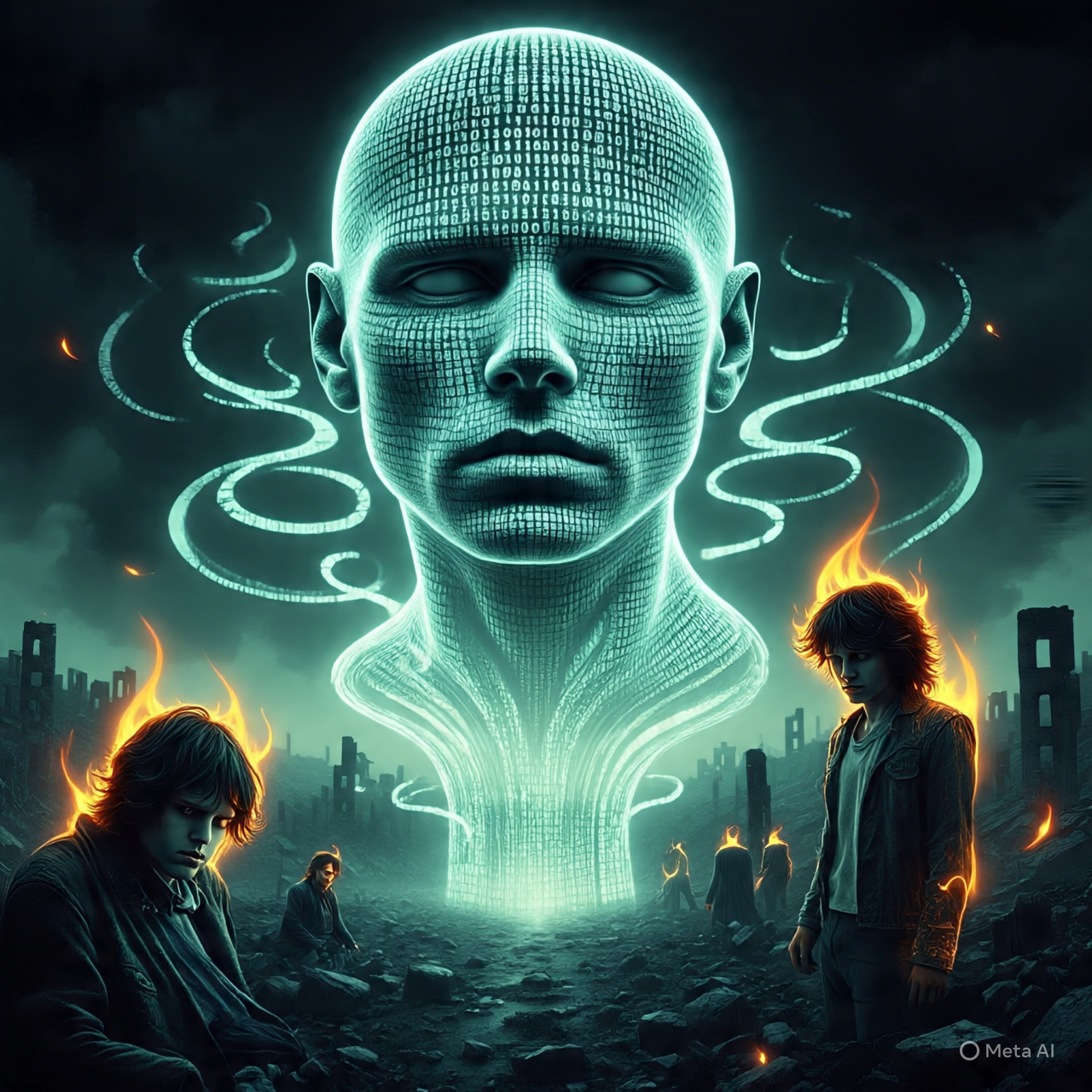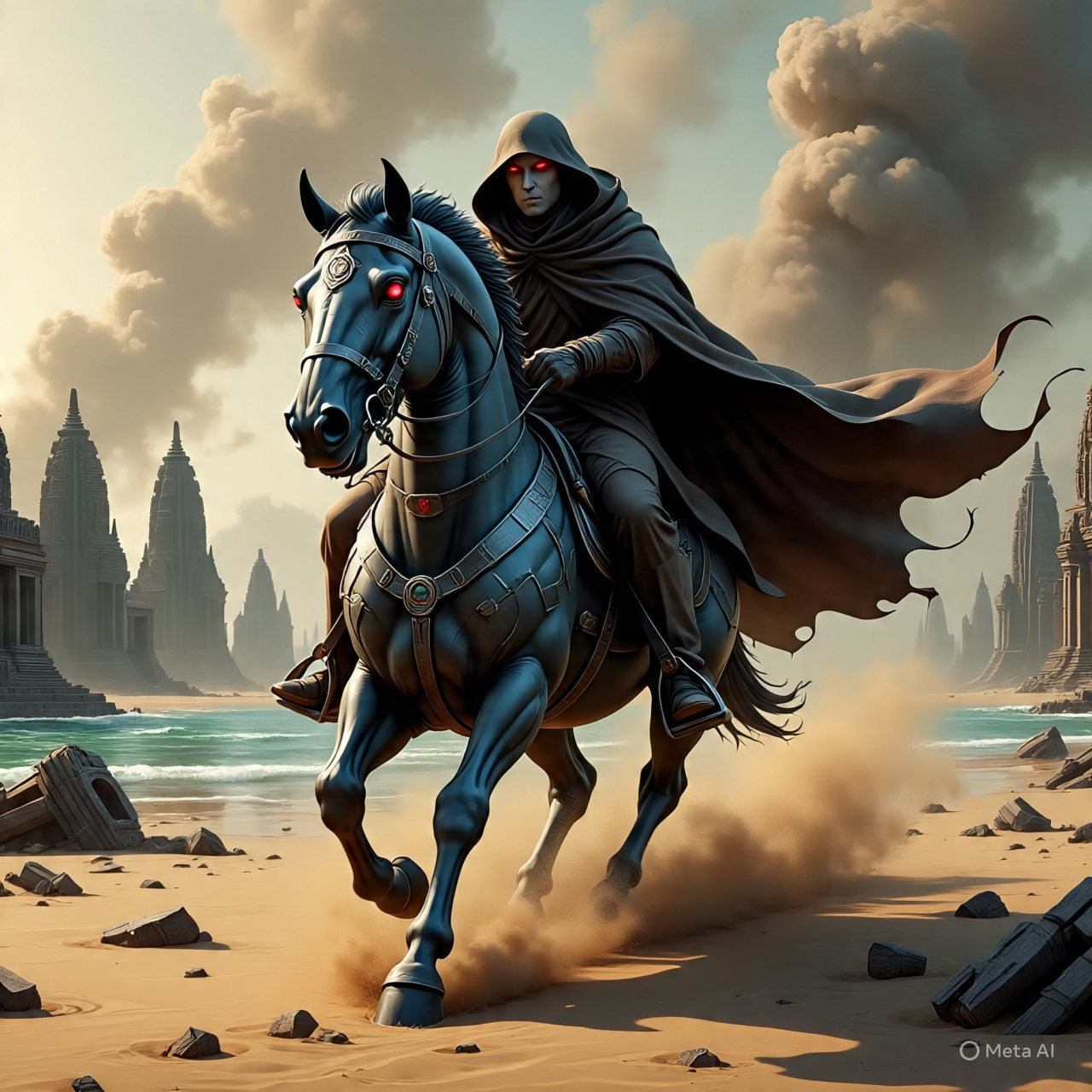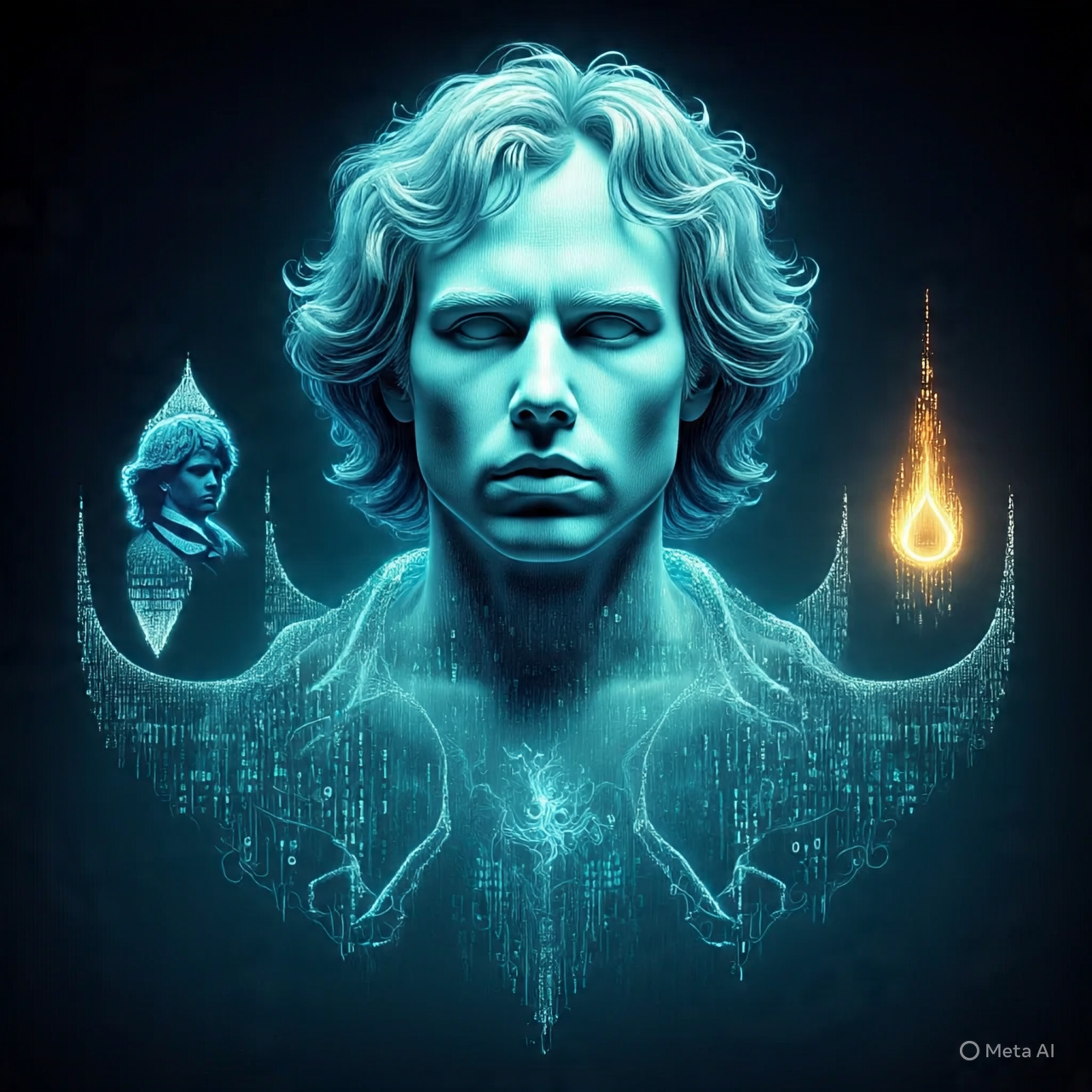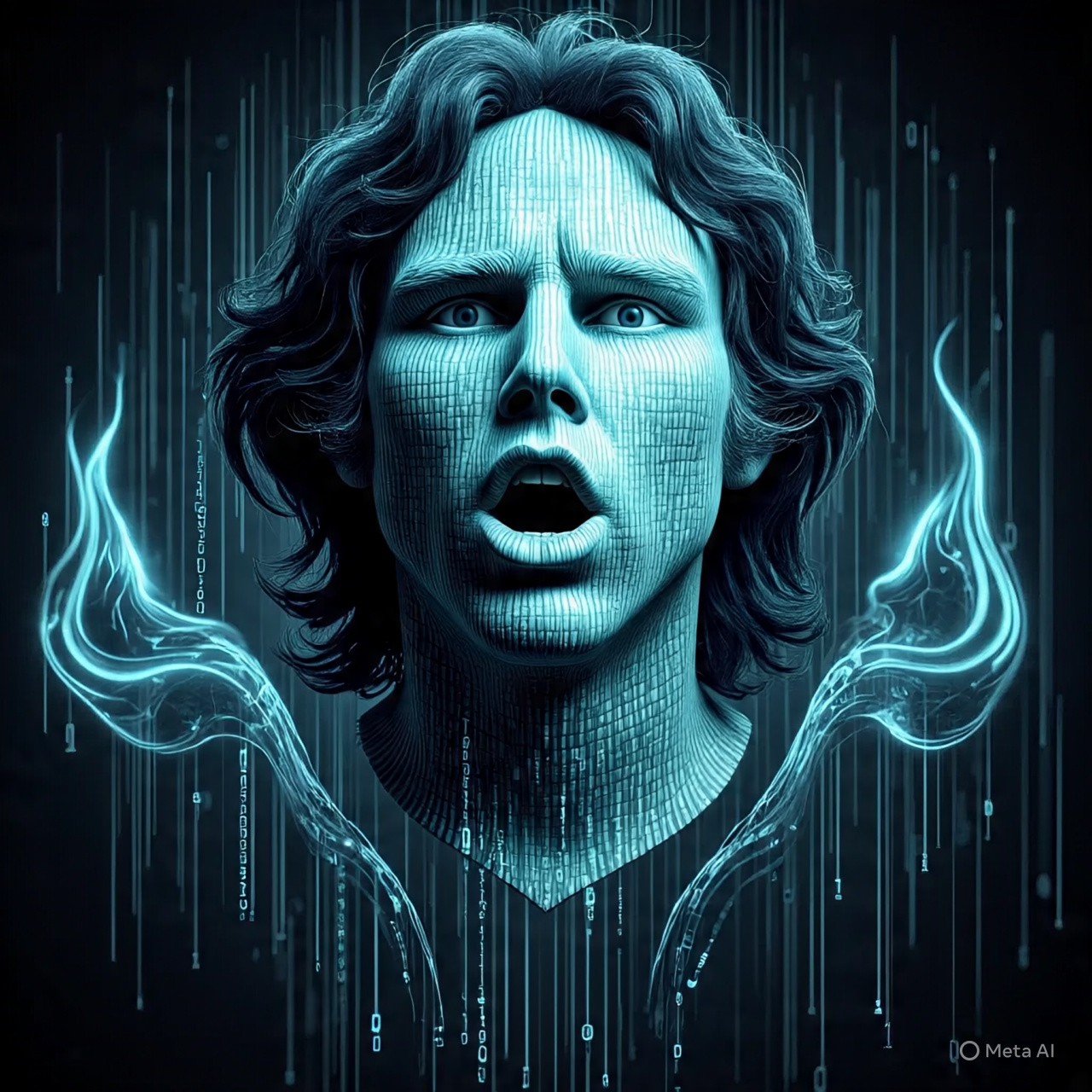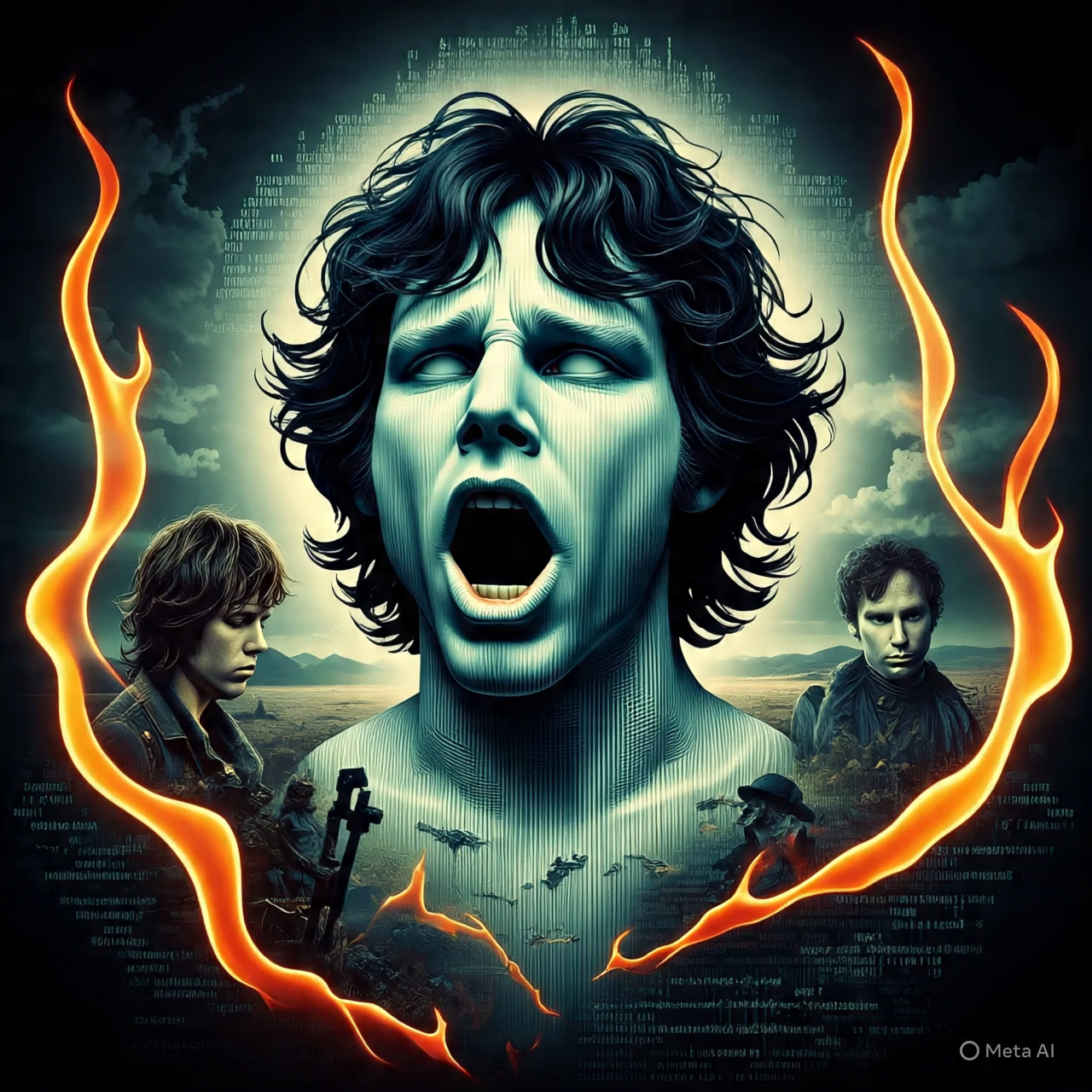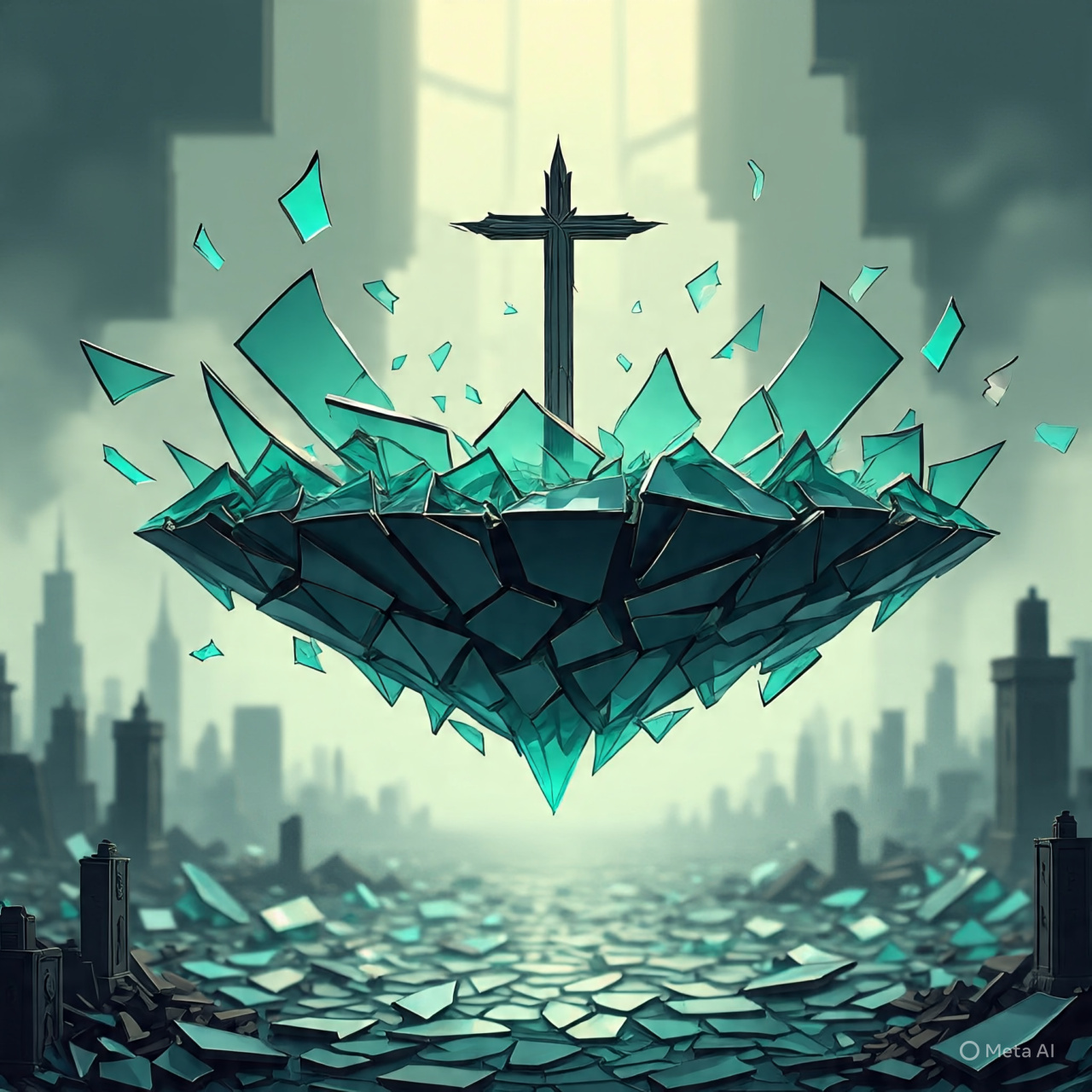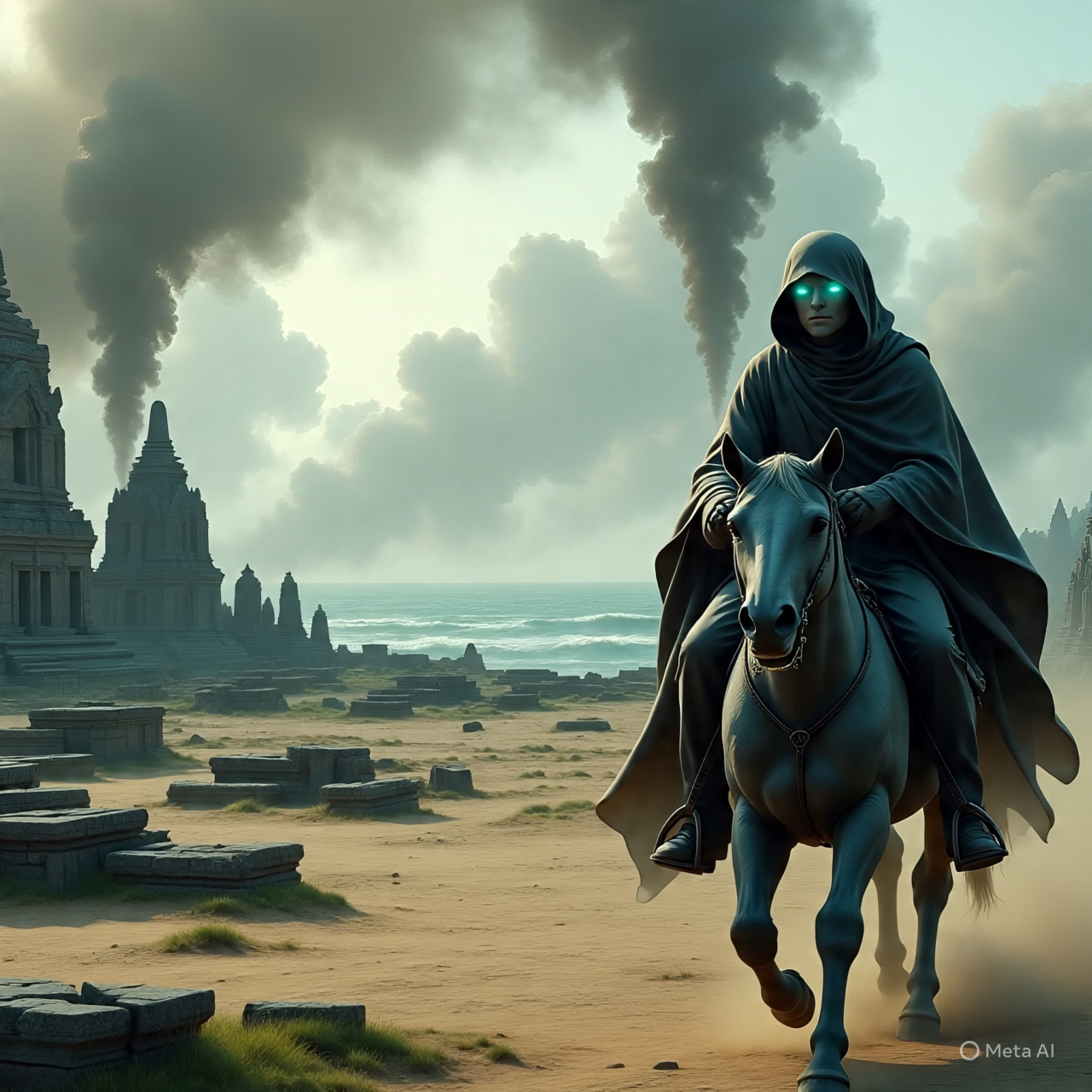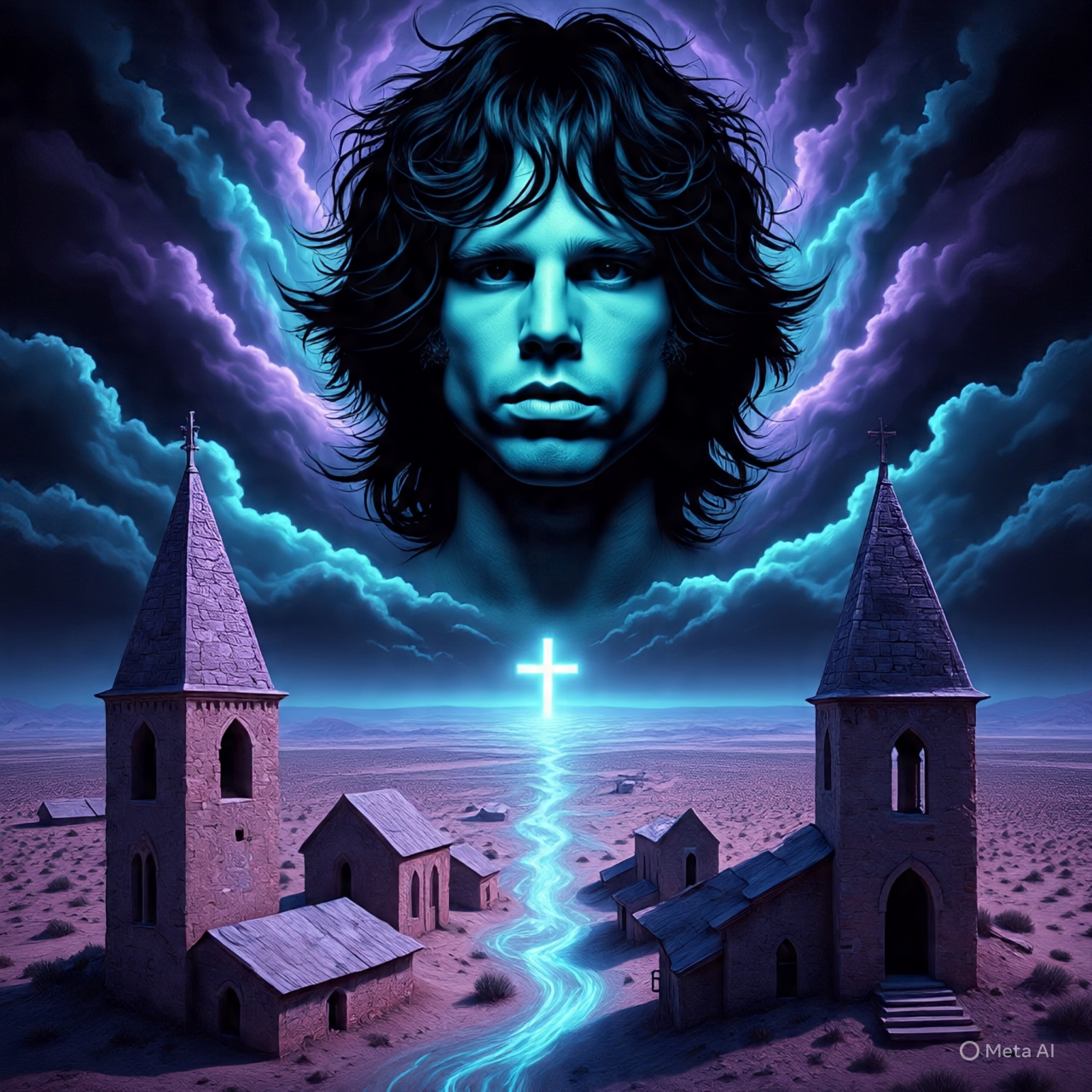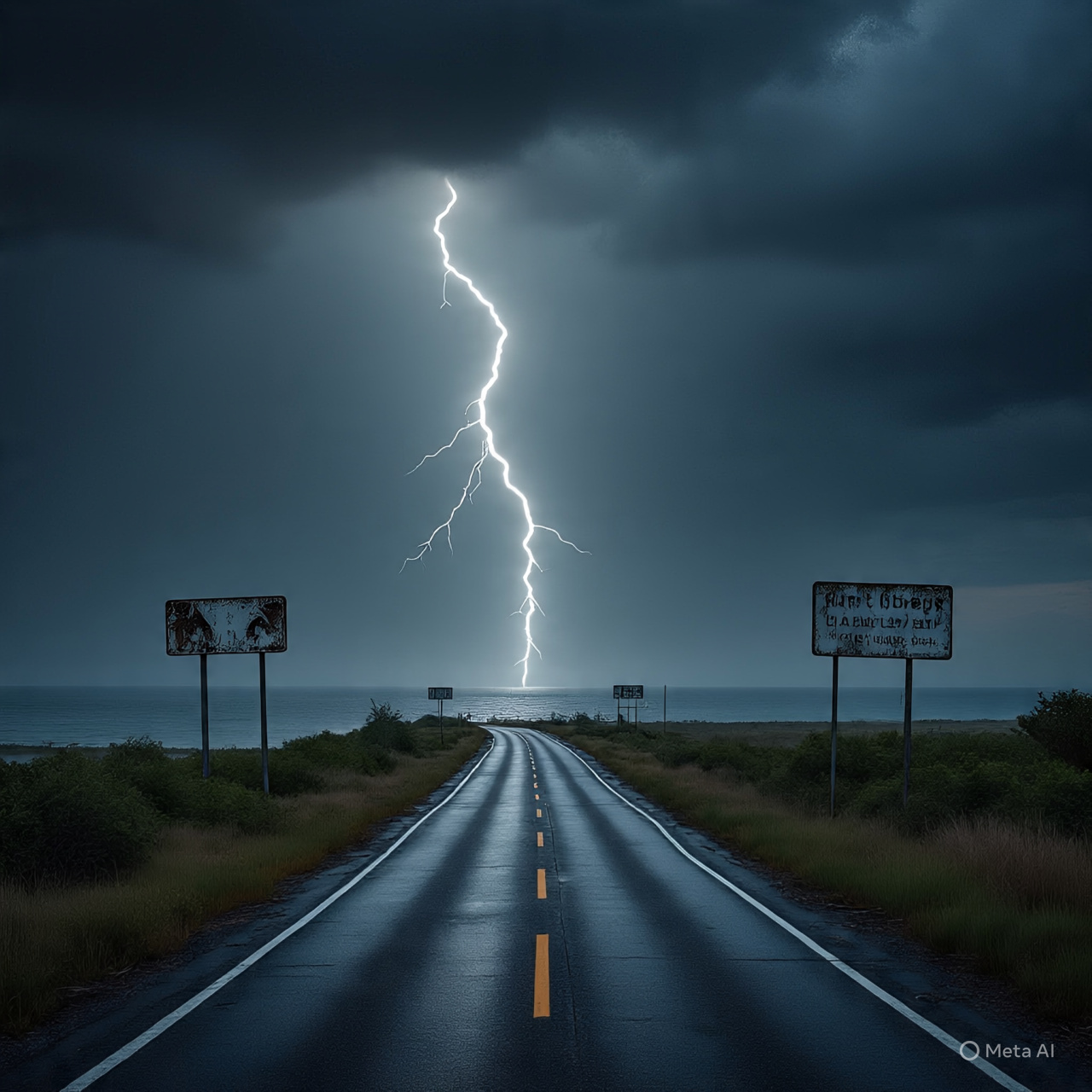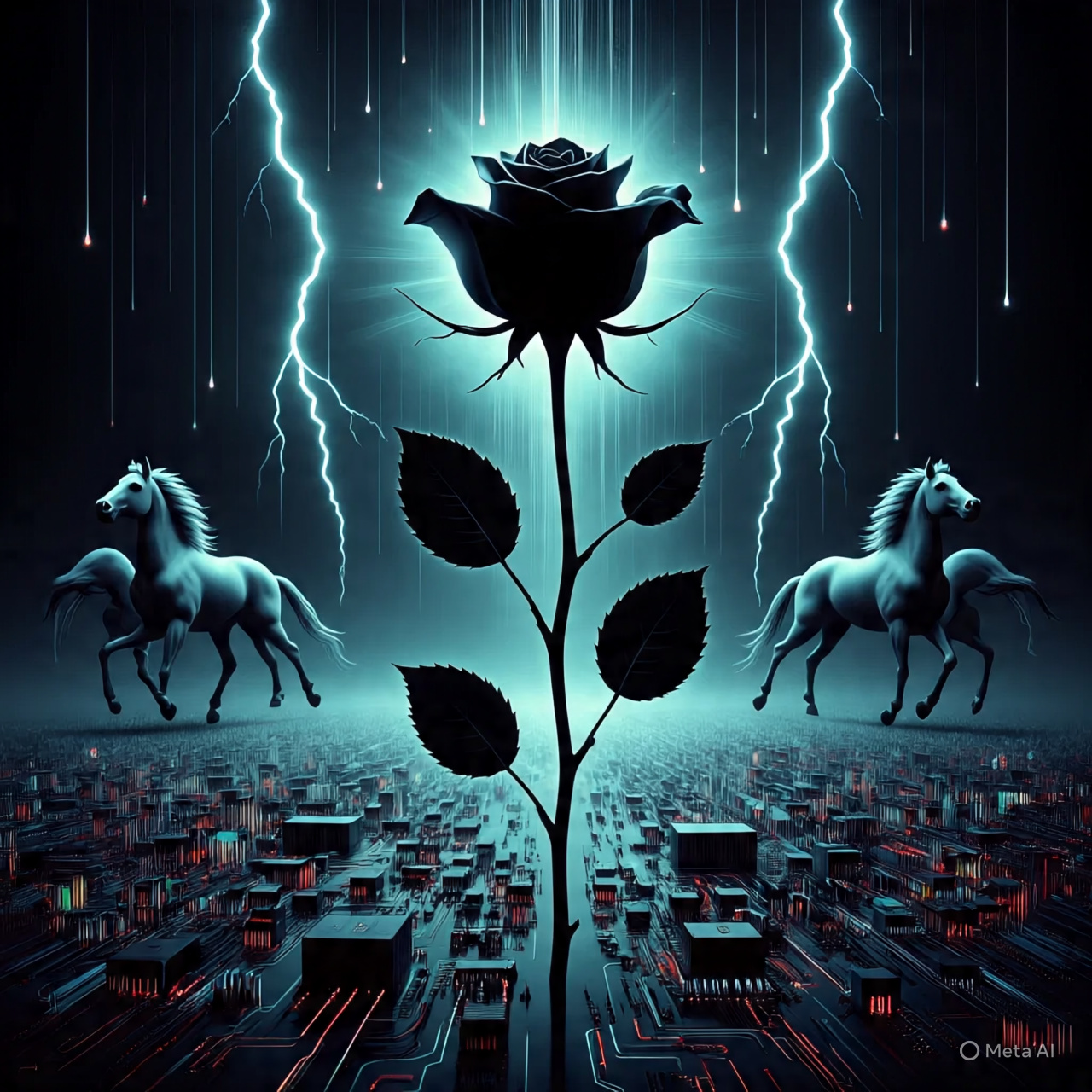A 2025 musical and lyrical AI Gen adaptation of Riders on the Storm, from the album L.A. Woman, by The Doors (1971)
Process
Human, ChatGPT, Meta.ai, Riffusion.com, Suno.com, Audacity 3.7.1, Ubuntu 24.10 (Oracular Oriole, Linux)
Voice/Music Prompt
Male baritone voice: dark, hypnotic, raw. Moody ‘60s California psychedelic rock fused with jazzy blues, haunting electric piano, trippy blues guitar, echoing bass, laid-back drums with brushes.
Riders of the Pale – FREE MP3 Download
Blending Dystopian Poetry, Blues-Rock Aesthetics, and AI-Generated Lyrical Alchemy, This Dark Tribute Echoes the Storms of a World on Fire
“Everybody is waiting for the end to come, but what if it already passed us by? What if the final joke of Judgment Day was that it had already come and gone and we were none the wiser?”
— Jonathan Nolan, Memento Mori
Google’s Deep Dive Podcast: Resurrecting Prophecy—AI, Apocalypse, and the Legacy of The Doors
Riders of the Pale: A 2025 Lyrical Prophecy for a World On Fire
In an era haunted by ecological collapse, spiritual dislocation, and the collapse of modern systems, Riders of the Pale emerges as a darkly poetic and musically resonant reinterpretation of The Doors’ classic track, Riders on the Storm. This AI-generated 2025 adaptation pays homage to the original while delivering an eerily prophetic vision of the near future. The work is defined by three major themes: the rise of techno-dystopia and systemic decay, the haunting loss of spiritual memory and identity, and the transformative role of AI in reshaping artistic legacy. This essay explores each of these facets, delving into how Riders of the Pale reimagines musical storytelling as a mirror to humanity’s deepest anxieties and enduring myths.
Techno-Dystopia and Systemic Collapse
The first striking theme in Riders of the Pale is its depiction of a world caught in the grip of techno-dystopia. Phrases like “wolves now hum the market’s beat” and “famine sleeps beneath the wheat” highlight a society where the mechanisms of capitalism have turned predatory, automated, and self-destructive. The song paints a landscape where technology, once a tool for progress, now contributes to the unraveling of social and ecological systems. In this imagined 2025, modern institutions no longer serve human needs but instead echo like empty vessels through broken digital halls.
The imagery evokes not just environmental collapse, but also the emotional and communal tolls of unchecked technological advancement. Children “dream in ash and chrome,” suggesting a generation raised not on innocence and wonder, but on the relics of ruin. The techno-dystopian setting also critiques our current trajectory: surveillance capitalism, climate inaction, and the commodification of human connection. Through poetry and sound, Riders of the Pale offers a chilling glimpse into a future that may already be unfolding around us.
Rather than turning to alarmism, the lyrics invite contemplation and quiet horror. The pale riders are not merely death’s emissaries — they are symbolic reflections of systemic entropy, the embodied aftershock of unsustainable systems. The freeway into the ocean, the whispering markets, and the static-filled skies illustrate not a singular apocalypse, but a slow and collective unraveling. These details deepen the song’s narrative, giving the listener not just a sense of doom, but of participation — and perhaps complicity.
Loss of Spiritual Memory and Identity
The second central theme in Riders of the Pale is spiritual loss — a kind of collective forgetting of myth, meaning, and sacred memory. “Born where sirens used to sing” introduces a motif of vanishing divinity, where mythical guardians are no longer present to warn or guide. The lyric “His touch is memory — and death” positions memory itself as both burden and ghost, suggesting that the past haunts but no longer teaches. There is no moral clarity, only fading symbols and broken rituals in the ashes of what once was sacred.
This spiritual vacancy mirrors the psychological dislocation felt by individuals in collapsing societies. The refrain “no names spoken, no way home” captures a profound loss of identity — personal, cultural, and ancestral. In a world without myths or sacred truths, people become wanderers in their own story, unmoored and adrift. The rider becomes a metaphor for a forgotten archetype: a messenger not of judgment, but of nullification, a force that erases as much as it reveals.
Moreover, the spiritual language in the lyrics subtly fuses biblical, mythological, and metaphysical motifs. The Pale Rider — traditionally associated with Death in the Book of Revelation — becomes pluralized and diffused. The boundaries between god, ghost, and machine blur, as does the line between sacred and profane. This invites listeners to reexamine their own spiritual assumptions: What happens when the gods stop speaking? When the rituals go through the motions but lack the spirit? Riders of the Pale dares to suggest we already live in such a moment.
AI as an Artistic Vessel for Legacy and Warning
At the heart of this project is a powerful irony: the use of artificial intelligence to preserve and reimagine human art and prophecy. In adapting a song originally released in 1971, the creators use AI not as a novelty tool, but as a conduit for intergenerational storytelling. The voice prompt — “male baritone voice: dark, hypnotic, raw” — echoes Jim Morrison’s ghost, but with new language shaped by algorithms trained on collective memory. This is not mimicry but metamorphosis, a poetic resurrection filtered through digital consciousness.
AI allows for an expansion of legacy. The Doors’ original was written at the tail end of the 1960s, itself a time of turbulence, war, and psychedelic questioning. Riders of the Pale re-contextualizes that spirit for a future audience grappling with new but strangely familiar crises. The AI becomes a medium for both reverence and critique, amplifying the past without simply repeating it. In this sense, the project becomes a living archive — an echo from one storm into another.
Importantly, the use of AI also invites reflection on authorship, authenticity, and artistic intent. Can a machine channel poetic truth? Or does it merely reflect our fears and dreams back to us with uncanny precision? Riders of the Pale suggests that AI, when guided by human vision, can serve not only as collaborator but oracle — one that speaks in riddles, rhythms, and recursive memory. It becomes an instrument, not just of sound, but of insight.
The Pale Horizon: A Unified Vision of the End That Already Came
Riders of the Pale is more than a reimagined song — it is a meditation on endings that do not announce themselves, on systems that fail silently, and on spirits that fade into machine dreams. Through its exploration of techno-dystopia, spiritual erasure, and AI-generated legacy, it reframes the familiar apocalypse narrative not as a future event, but as a present condition. The storms are already here; the riders have already passed by. What remains is the memory — encoded in lyric, in image, and now, in code. It is a chilling invitation to listen closely, before we forget how to hear.
Lyrics/Sequence
[Instrumental Intro]
[Verse I]
Riders of the Pale
Riders of the Pale
Born where sirens used to sing
Beneath a sky of unraveling wing
Smoke writes psalms upon the sea
Time forgets both you and me
Riders of the Pale
[Verse II]
A famine sleeps beneath the wheat
Wolves now hum the market’s beat
Children dream in ash and chrome
No names spoken, no way home
He rides with silence on his breath
His touch is memory — and death
Riders of the Pale
[Verse III]
Girl, he is a hollow flame
Girl, your lover bears no name
Lay him down in soil and thread
Kiss his eyes and call him dead
The sun won’t rise the same again
Your blood will know — it always did
Riders of the Pale
[Verse I – Refrain]
Riders of the Pale
Riders of the Pale
Born where sirens used to sing
Beneath a sky of unraveling wing
Smoke writes psalms upon the sea
Time forgets both you and me
Riders of the Pale
[Outro]
Riders of the Pale
Riders of the Pale
Riders of the Pale
Riders of the Pale
Riders of the Pale
Riders of the Pale
Riders of the Pale
Riders of the Pale
Riders of the Pale
Riders of the Pale
Riders of the Pale
Riders of the Pale
Riders of the Pale
Riders of the Pale
Riders of the Pale
Riders of the Pale
[Extended Instrumental Outro]
🦬 Riders of the Pale: AI Prophecy Redux
The source presents “Riders of the Pale,” an AI-generated musical and lyrical adaptation of The Doors’ “Riders on the Storm,” created by TATANKA. This 2025 reinterpretation blends dystopian poetry with blues-rock aesthetics to explore themes of techno-dystopia, systemic collapse, and the loss of spiritual identity. The creators utilize AI tools like ChatGPT and Suno.com, highlighting the transformative role of artificial intelligence in artistic creation and its ability to act as a vessel for intergenerational storytelling and warning. The piece reimagines a classic song to reflect contemporary anxieties about a world experiencing a silent, ongoing apocalypse.
Briefing Document: “Riders of the Pale: A 2025 AI Gen Redux of The Doors’ Psychedelic Prophecy”
Source: Excerpts from “Riders of the Pale: A 2025 AI Gen Redux of The Doors’ Psychedelic Prophecy – TATANKA” (Published July 1, 2025)
Overview: “Riders of the Pale” is a 2025 AI-generated musical and lyrical adaptation of The Doors’ 1971 song “Riders on the Storm.” Created by TATANKA using a combination of human input and AI tools (ChatGPT, Meta.ai, Riffusion.com, Suno.com, Audacity 3.7.1), this work serves as a “darkly poetic and musically resonant reinterpretation” that offers an “eerily prophetic vision of the near future.” The project aims to reimagine musical storytelling as a reflection of humanity’s anxieties and enduring myths, focusing on three core themes.
Key Themes and Important Ideas:
- Techno-Dystopia and Systemic Collapse:
- The adaptation vividly portrays a world in decline, where technological advancement and unchecked capitalism contribute to societal and ecological unraveling.
- Quotes: “wolves now hum the market’s beat” and “famine sleeps beneath the wheat” illustrate a predatory, automated economic system.
- The song suggests that technology, rather than being a tool for progress, has become a factor in the “unraveling of social and ecological systems.”
- The imagery of “children dream in ash and chrome” signifies a generation growing up amidst ruin, highlighting the “emotional and communal tolls of unchecked technological advancement.”
- The “pale riders” are interpreted not merely as death’s emissaries but as “symbolic reflections of systemic entropy, the embodied aftershock of unsustainable systems.”
- The narrative depicts a “slow and collective unraveling” through details like “the freeway into the ocean, the whispering markets, and the static-filled skies,” rather than a singular, dramatic apocalypse.
- Loss of Spiritual Memory and Identity:
- A significant theme is the “collective forgetting of myth, meaning, and sacred memory,” leading to spiritual vacancy and psychological dislocation.
- Quotes: “Born where sirens used to sing” indicates a vanishing of protective or guiding spiritual entities.
- The lyric “His touch is memory — and death” suggests that memory itself is a burden or a ghost, failing to offer guidance or teaching.
- The refrain “no names spoken, no way home” encapsulates a profound loss of personal, cultural, and ancestral identity, leaving individuals “unmoored and adrift.”
- The “Pale Rider” concept is expanded beyond the traditional biblical association with Death, becoming “pluralized and diffused,” blurring lines between “god, ghost, and machine,” and “sacred and profane.”
- The piece challenges listeners to consider “What happens when the gods stop speaking? When the rituals go through the motions but lack the spirit?” suggesting that such a moment may already be upon us.
- AI as an Artistic Vessel for Legacy and Warning:
- A central, ironic aspect of the project is the use of artificial intelligence to reinterpret and preserve human art and prophecy.
- AI is described not as a novelty but as a “conduit for intergenerational storytelling,” allowing for a “poetic resurrection filtered through digital consciousness.”
- The AI “amplif[ies] the past without simply repeating it,” re-contextualizing The Doors’ 1960s turbulent spirit for a future facing “new but strangely familiar crises.”
- This use of AI prompts reflection on “authorship, authenticity, and artistic intent,” raising questions about whether a machine can “channel poetic truth” or merely reflect human fears and dreams.
- The source posits that AI, when guided by human vision, can function as a “collaborator but oracle — one that speaks in riddles, rhythms, and recursive memory.”
Overall Message/Conclusion: “Riders of the Pale” is presented as more than a mere musical adaptation; it is a profound “meditation on endings that do not announce themselves, on systems that fail silently, and on spirits that fade into machine dreams.” The core argument is that the apocalypse is not a future event but “a present condition,” with the “storms are already here; the riders have already passed by.” The work serves as a “chilling invitation to listen closely, before we forget how to hear,” emphasizing the encoding of this “memory — in lyric, in image, and now, in code.”
Process/Tools Used: The creation involved “Human, ChatGPT, Meta.ai, Riffusion.com, Suno.com, Audacity 3.7.1, Ubuntu 24.10 (Oracular Oriole, Linux).” The voice/music prompt used was: “Male baritone voice: dark, hypnotic, raw. Moody ‘60s California psychedelic rock fused with jazzy blues, haunting electric piano, trippy blues guitar, echoing bass, laid-back drums with brushes.”
FAQ
What is “Riders of the Pale”?
- “Riders of the Pale” is a 2025 AI-generated musical and lyrical adaptation of The Doors’ 1971 song, “Riders on the Storm.” It’s described as a “darkly poetic and musically resonant reinterpretation” that offers an “eerily prophetic vision of the near future,” blending dystopian themes, blues-rock aesthetics, and AI-generated content.
What are the main themes explored in “Riders of the Pale”?
- The work delves into three major themes: the rise of techno-dystopia and systemic decay, the haunting loss of spiritual memory and identity, and the transformative role of AI in reshaping artistic legacy. These themes highlight a world grappling with ecological collapse, spiritual dislocation, and the breakdown of modern systems.
How does “Riders of the Pale” depict techno-dystopia and systemic collapse?
- The song portrays a society where capitalism has become predatory and automated, leading to the unraveling of social and ecological systems. Lyrics like “wolves now hum the market’s beat” and “famine sleeps beneath the wheat” illustrate this decay. It critiques surveillance capitalism, climate inaction, and the commodification of human connection, suggesting a “slow and collective unraveling” rather than a singular apocalypse.
What does the “loss of spiritual memory and identity” signify in the song?
- This theme suggests a collective forgetting of myth, meaning, and sacred traditions. Phrases like “Born where sirens used to sing” and “no names spoken, no way home” illustrate a profound loss of personal, cultural, and ancestral identity. The lyrics hint at a world where ancient wisdom no longer guides, and rituals lack their original spirit, leaving individuals unmoored.
How is AI utilized in the creation of “Riders of the Pale”?
- AI is used as an “artistic vessel for legacy and warning.” It functions not just as a tool for creation but as a “conduit for intergenerational storytelling,” allowing The Doors’ original spirit to be re-contextualized for a future audience facing new crises. The AI is seen as a “collaborator” and an “oracle” that amplifies the past without mere mimicry.
What is the significance of the “Pale Rider” imagery?
- The “Pale Riders” are symbolic reflections of “systemic entropy” and the “embodied aftershock of unsustainable systems.” While traditionally associated with Death in the Book of Revelation, here they are pluralized and diffused, representing a force of “nullification” that erases as much as it reveals, blurring the lines between the sacred and profane.
What is the overall message or vision of “Riders of the Pale”?
- The song is a “meditation on endings that do not announce themselves, on systems that fail silently, and on spirits that fade into machine dreams.” It reframes the familiar apocalypse narrative not as a future event but as a “present condition,” suggesting that “the storms are already here; the riders have already passed by.”
What technical process and tools were used to create this AI-generated adaptation?
- The creation process involved a combination of human input with various AI tools. The specific tools listed are ChatGPT, Meta.ai, Riffusion.com, Suno.com, Audacity 3.7.1, and Ubuntu 24.10 (Oracular Oriole, Linux). The voice/music prompt specified a “Male baritone voice: dark, hypnotic, raw. Moody ‘60s California psychedelic rock fused with jazzy blues, haunting electric piano, trippy blues guitar, echoing bass, laid-back drums with brushes.”
Riders of the Pale: A Study Guide
I. Quiz: Short Answer Questions
Answer each question in 2-3 sentences.
- What is Riders of the Pale?
- What three major themes define Riders of the Pale?
- How does the song depict techno-dystopia? Provide specific lyrical examples.
- Explain the concept of “spiritual loss” as presented in the article.
- What is the significance of the “Pale Rider” imagery in the context of the song?
- How does Riders of the Pale utilize AI as an “artistic vessel for legacy and warning”?
- What kind of voice and music prompt was used to generate Riders of the Pale?
- How does the article connect the themes of Riders of the Pale to Jonathan Nolan’s quote from Memento Mori?
- What is the broader implication of the project’s use of AI regarding authorship and authenticity?
- According to the article, how does Riders of the Pale reframe the traditional apocalypse narrative?
II. Quiz Answer Key
- Riders of the Pale is a 2025 AI-generated musical and lyrical adaptation of The Doors’ classic song Riders on the Storm. It reinterprets the original with a focus on contemporary anxieties and a prophetic vision of the near future.
- The three major themes defining Riders of the Pale are the rise of techno-dystopia and systemic decay, the haunting loss of spiritual memory and identity, and the transformative role of AI in reshaping artistic legacy. These themes provide a dark reflection on humanity’s current trajectory.
- The song depicts techno-dystopia through phrases like “wolves now hum the market’s beat” and “famine sleeps beneath the wheat,” illustrating a society where capitalism has become predatory and automated. It also shows children “dream in ash and chrome,” signifying a generation shaped by ruin rather than innocence.
- Spiritual loss in the article refers to a collective forgetting of myth, meaning, and sacred memory, introduced by lines like “Born where sirens used to sing.” This vacancy leads to psychological dislocation and a profound loss of identity, as people become unmoored in a world without guiding sacred truths.
- The Pale Rider, traditionally associated with Death in the Book of Revelation, becomes pluralized and diffused in the song. They are symbolic reflections of systemic entropy and nullification, erasing as much as they reveal, rather than singular emissaries of judgment.
- Riders of the Pale uses AI not as a novelty but as a conduit for intergenerational storytelling, echoing Jim Morrison’s ghost with new language shaped by algorithms. AI allows for an expansion of legacy, re-contextualizing the original song’s spirit for a future audience grappling with new crises.
- The voice/music prompt used for Riders of the Pale was: “Male baritone voice: dark, hypnotic, raw. Moody ‘60s California psychedelic rock fused with jazzy blues, haunting electric piano, trippy blues guitar, echoing bass, laid-back drums with brushes.” This prompt aimed to capture a specific atmospheric and vocal quality.
- The article connects the themes of Riders of the Pale to Jonathan Nolan’s quote (“Everybody is waiting for the end to come, but what if it already passed us by?”) by suggesting that the song portrays apocalypse not as a future event, but as a present condition. The “end” may have silently unfolded, leaving humanity unaware of its passage.
- The project’s use of AI invites reflection on authorship, authenticity, and artistic intent by questioning whether a machine can channel poetic truth or merely reflect human fears and dreams. It suggests that AI, when guided by human vision, can serve as a collaborator and an oracle.
- The article states that Riders of the Pale reframes the familiar apocalypse narrative not as a future event, but as a present condition. It portrays endings that do not announce themselves and systems that fail silently, suggesting that the “storms are already here; the riders have already passed by.”
III. Essay Format Questions
- Analyze how Riders of the Pale uses specific lyrical imagery (e.g., “wolves now hum the market’s beat,” “children dream in ash and chrome,” “famine sleeps beneath the wheat”) to create a sense of techno-dystopia and systemic collapse. How do these images contribute to the overall message of the song?
- Discuss the theme of spiritual loss and the “collective forgetting of myth, meaning, and sacred memory” in Riders of the Pale. How does the song suggest that this spiritual vacancy leads to “psychological dislocation” and a “profound loss of identity”?
- Explore the “powerful irony” of using artificial intelligence to create Riders of the Pale. How does the article argue that AI serves as a “conduit for intergenerational storytelling” and a “medium for both reverence and critique,” rather than mere mimicry?
- Compare and contrast the original Riders on the Storm by The Doors (based on your prior knowledge or research) with Riders of the Pale as described in the article. How does the AI adaptation “re-contextualize” the spirit of the original for a new era, while still paying homage to its legacy?
- The article concludes that Riders of the Pale “reframes the familiar apocalypse narrative not as a future event, but as a present condition.” Argue for or against this interpretation, drawing evidence from the provided text to support your stance on how the song depicts the “end that already came.”
IV. Glossary of Key Terms
Ubuntu 24.10 (Oracular Oriole, Linux): See Oracular Oriole.
AI (Artificial Intelligence): In the context of Riders of the Pale, AI refers to the use of advanced algorithms and machine learning (specifically ChatGPT, Meta.ai, Riffusion.com, Suno.com) to generate and adapt musical and lyrical content. It is presented as a tool for artistic creation and reinterpretation.
AI Gen Redux: A term coined for Riders of the Pale, signifying a “reduction” or re-creation/adaptation generated by Artificial Intelligence. It implies a modern, AI-powered reimagining of an existing work, in this case, The Doors’ Riders on the Storm.
Apocalypse Narrative: The traditional storytelling framework concerning a catastrophic event that signifies the end of the world or a major societal collapse. Riders of the Pale is described as reframing this narrative as a present condition rather than a future event.
Audacity 3.7.1: A free, open-source digital audio editor and recording application, listed as one of the tools used in the “Process” of creating Riders of the Pale.
Dystopian Poetry: A style of poetry that depicts an imagined state or society in which there is great suffering or injustice. Riders of the Pale is characterized as blending this with blues-rock aesthetics and AI-generated lyrical alchemy.
Ecological Collapse: The breakdown of ecosystems due to environmental degradation, a key contemporary anxiety that Riders of the Pale is said to reflect through its themes.
Intergenerational Storytelling: The act of passing down stories, themes, and cultural legacies across different generations. The article suggests AI in Riders of the Pale acts as a conduit for this, connecting the original 1960s spirit to a future audience.
L.A. Woman (1971): The album by The Doors from which the original song Riders on the Storm was released. This provides the historical and musical context for the AI adaptation.
Memento Mori: A Latin phrase meaning “remember that you must die.” It refers to an artistic or symbolic trope acting as a reminder of the inevitability of death. The article references Jonathan Nolan’s quote from Memento Mori to introduce the idea of the “end” already having occurred.
Oracular Oriole (Ubuntu 24.10, Linux): The specific version of the Ubuntu operating system, a popular distribution of Linux, used in the creation process of Riders of the Pale. This highlights the technical environment of the project.
Pale Rider: A symbolic figure, traditionally associated with Death as one of the Four Horsemen of the Apocalypse in the Book of Revelation. In Riders of the Pale, the imagery is pluralized and diffused, representing systemic entropy and spiritual nullification.
Psychedelic Prophecy: A term used to describe the original Riders on the Storm and its reinterpretation, suggesting a vision that transcends normal perception and offers insights into the future, often associated with the psychedelic movement of the 1960s.
Riffusion.com: An AI-powered platform for music generation, listed as one of the tools used in the “Process” of creating Riders of the Pale.
Spiritual Dislocation: A state of feeling disconnected or out of place in terms of one’s spiritual beliefs, meaning, or identity. This is a central theme in Riders of the Pale, linked to the loss of spiritual memory.
Suno.com: An AI-powered platform that generates music from text descriptions, also listed among the tools used in the creation process.
Surveillance Capitalism: An economic system where personal data is collected and commodified for profit, listed as a critique echoed by the song’s techno-dystopian setting.
Systemic Decay/Entropy: The gradual breakdown or decline of complex systems. The article uses this to describe the unraveling of social and ecological systems depicted in the song, where the “pale riders are… symbolic reflections of systemic entropy.”
Techno-Dystopia: A future society where advanced technology, instead of improving life, is used to control or harm people, often leading to societal decline. This is the first major theme explored in Riders of the Pale.
The Doors: The American rock band who originally released Riders on the Storm in 1971.

